

On this Page
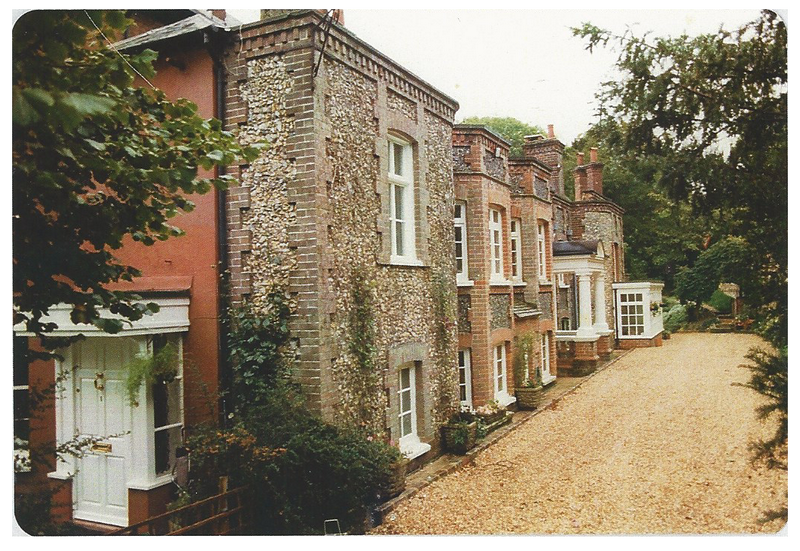
Although It is unknown when the house was built and the Deeds have, unfortunately, not survived, there is every indication to suggest the property dates from the Georgian period.
Very little has been found about the first known owner occupier of the property, Jabez Millard, but in 1818 he was included in the List of 'Members of the Baptists' and that he resided In Loosley Row.
He is also recorded in the 'Register and Map of Property Owners' before the lnclosures of 1823 as owner of the Freehold property at No. 576 on the map, described as "House, Garden and Paddock" and also No. 624, "Allotment" of land opposite the house, which was later used as a kitchen garden. These can be seen on this section of map.
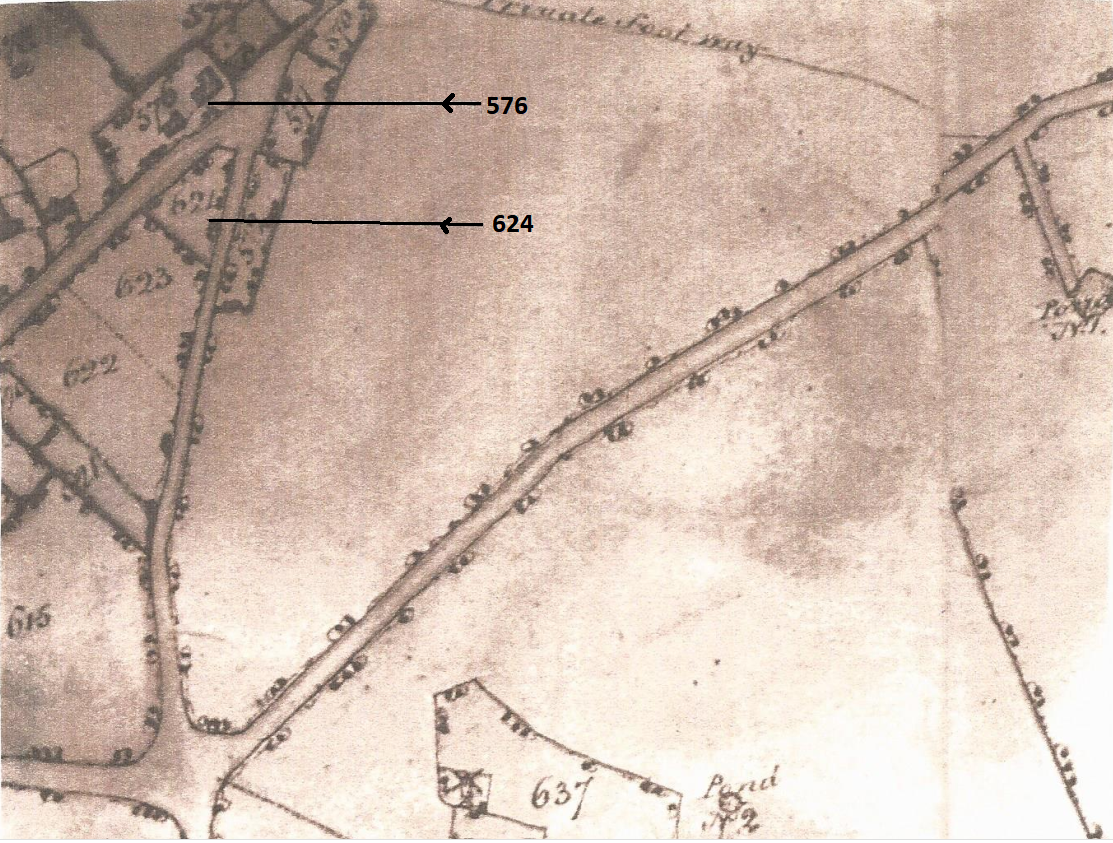
The road between the properties is today's Lower Road
George, the youngest son of James and Anne Stephen, was born in 1794 at St Kitts, West Indies where James held a Government appointment.
It was initially hoped that George would join the medical section of the army, but after the defeat of Napoleon at Leipzig in 1813 hundreds of young men in the army medical staff had to seek alternative employment. George went on a three year course at Magdalene College, Cambridge with the intention of becoming a physician, but after studying law, decided that was the profession he wished to follow. Having served a long apprenticeship with a Mr Fresfield, the Solicitor of The Bank of England, he commenced to practise on his own account.
A campaign formed to help abolish slavery, The Clapham Sect, included British politician William Wilberforce and his brother-in-law James Stephen whom, after his first wife Anne died, had married William's sister. Later, James' son George also became deeply involved with the cause and was one of the leading campaigners, which eventually led to the prohibition of slavery.
On 17th March 1821 in Kensington, George Stephen married Henrietta Ravenscroft. Their first child, James Wilberforce Stephen was born on 10th April 1822 and Baptlsed on 10th July at St Margaret's Church, Westminster. The family resided at 38 Broad Street, London, where the next three children arrived at two year intervals. All were Baptised at St. Botolph-without, Bishopsgate, London:
1824 Henrietta Sibella;
1826 William Ravenscroft and 1828 George Milner Elmslie.
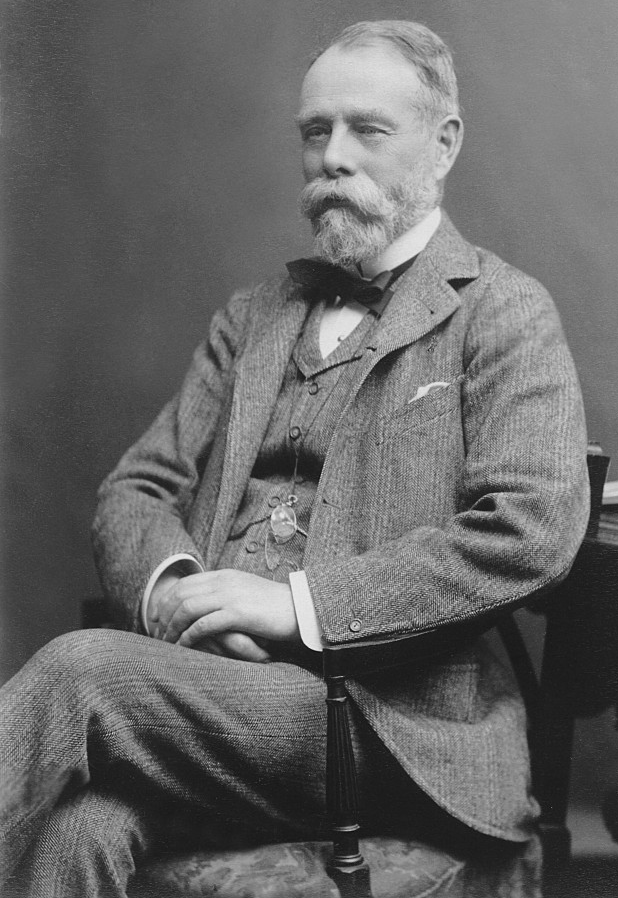
George Stephen's friend in Hampstead, dairy farmer John Collins, owned a spacious house large enough to let rooms to landscape painter, John Linnell and his family. Frequent guests were George Henrietta Stephen, poet William Blake and artist Samuel Palmer.
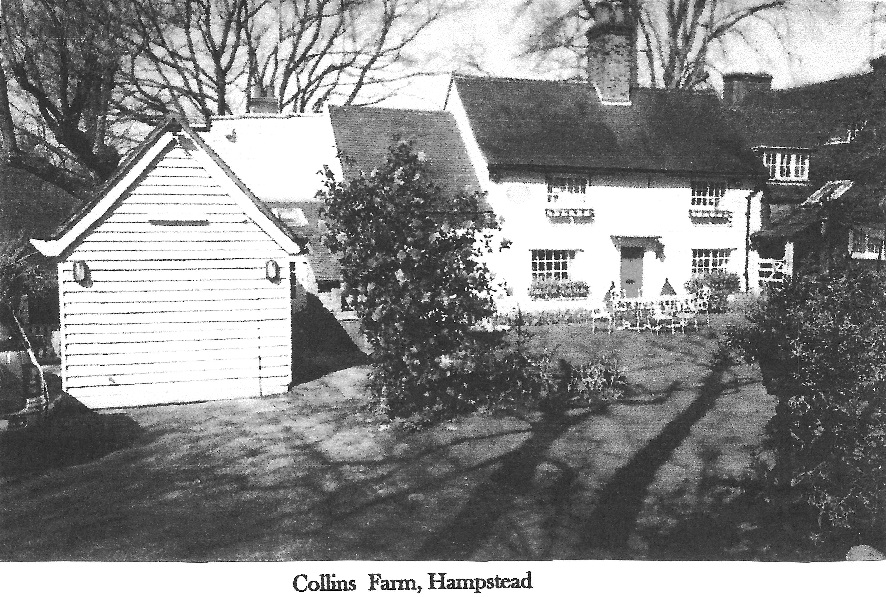
The building still exists but now called 'Wyldes Farm' and displays a blue plaque commemorating John Linell's tenancy. It also reported that poet William Blake was a frequent visitor between 1824 and 1827
About 1829 the Stephen family moved to Loosley Row and named the now Loosley House - 'Collins'. - after the Hampstead farmhouse of which he had fond memories. Sir George also purchased a farm and cottage nearby and also gave them the name Collins - Farm and Cottage.
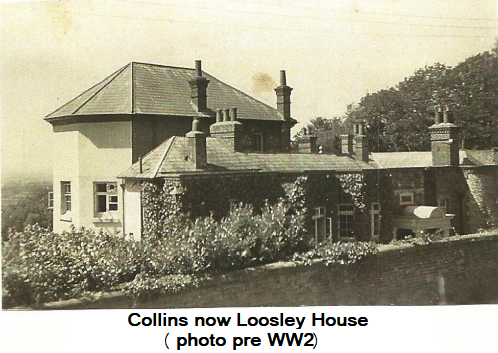
In 1833, Henrietta Stephen returned to the St John's Wood area, London where a daughter, Mary Anne was born.
Two more children were born at Looslev Row: Selina Hastings Robe, born 24 August 1835 and Baptised at St John's Church, Lacey Green on 13th October; and Hastings Fitzgerald Murphy, born 25 March 1837, Baptised 12 August. Entries in the Register of Baptisms for both, record: daughter/son of George and Henrietta Stephen Of 'Collins', Loosley Row, Solicitor.
In 1838 George Stephen was knighted by Queen Victoria for his work as a leading campaigner for the abolition of slavery. The official citation reads:
'At St James Palace, London on February 14th I838 The Queen was this day pleased to confer the honour of Knighthood upon George Stephen, Esquire of 'Collins', Princes Risborough in the County of Buckingham'.
In 1855 their first born son, James Wilberforce Stephen, emigrated to Australia and settled in Melbourne in the State of Victoria. He and his family to be would return to Loosley House in 1878...
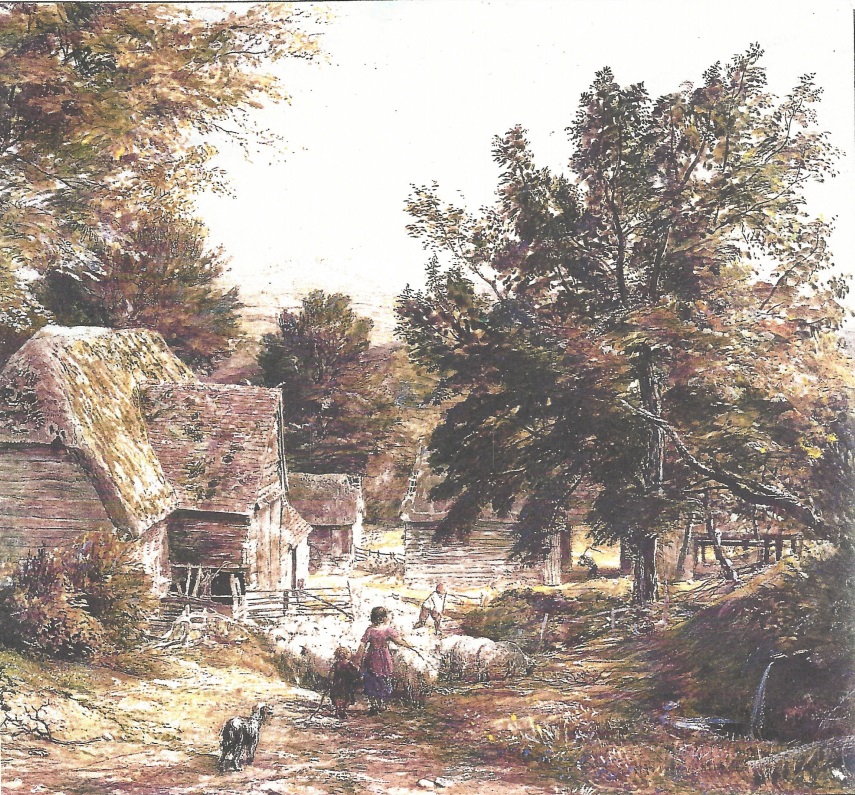
'A Farm house near Prince Risborough' by Samuel Palmer
A painting of Collins Farm, Loosley Row. Wain Hill (then called 'Bledlow Cop') can be seen in the background
Born c1815 at Coleshill, Hertfordshire, he attended Exeter College, Oxford where he gained a BA in 1835 and MA in 1837.
Becoming a Curate of Warbledon Sussex from 1838-1840; Great Missenden 1840-1844 and Aston Clinton 1844-1848.
Whilst the Parsonage at Lacey Green was being built he and his family lived at Loosley House from 1849 until relocating to Lacey Green.
The 1851 census records the large household of family and staff.
Loosley Row
| William J Burgess | Head | Mar. | 36 | Curate, Lacey Green | born:Herts. |
| Mary Ann B" | wife | 33 | Sarratt, Herts | ||
| Mary E B" | dau. | 8 | Gt Missenden | ||
| William R B" | son | 5 | Aston Clinton | ||
| Catherine Jane B" | dau. | 4 | Aston Clinton | ||
| John Francis C B" | son | 2 | Loosley Row | ||
| Ann Maria B" | dau. | 9 mn | Loosley Row | ||
| Ann Lockett | Servant | Widow | 51 | Canterbury | |
| Amelia Filbee | " | Unmar. | 21 | Gt.Mlssenden | |
| Priscilla Gambell | ," | " | 41 | Halton Bucks | |
| Emma Watson | " | " | 15 | London |
Two more sons were born in Loosley Row after the 1851 census was recorded - Arthur H in 1853 and George F in 1855.
In 1861, the whole Burgess family were staying in Bath, Somerset at 9 Raby Place, Bathwick taking one of their previous members of staff - Priscilla Gambell as Housemaid - all together with Ann Veal, a Cook, born in Cadbury, Somerset and a Footman, James Horwood, 51, Widower, born Middlesex.
During that time, James Horwood married Emma Watson (the youngest member of staff from Loosley Row).
Rev. William Burgess was author of 'Buckinghamshire Antiquities' and other papers kept in the Records of Buckinghamshire held by the Bucks Archaelogical and Antiquarian Society. He left Lacey Green in 1880 and became Rector of St Mary Magdalene, Stretton Sugwass, four miles west of Hereford; leaving there sometime in the 1880's for Epsom, Surrey, where he died on 7th February 1886.
Alfred was born on 5th June 1824 and Baptized at St Olave’s Church, Old Jewry, City of London on 6th October. He was one of the sons of Charles Pritchett and Sarah Bousfield. Charles was a silk manufacturer at 50 Cheapside and the family home at that time was 26 Old Jewry.
By 1841 they had moved to Sth Adelphi Place, Camberweil — a row of houses built between 1830-1834, long demolished, which stood in the area of Denmark Hill/Coldharbour Lane.
The census shows Charles Bousfield, aged 55, Silk Merchant, with five of his children, including 15 year old Alfred, whose 7 year old sister, Cornelia Sophia would eventually marry the Reverend Hugh Huleatt. Ten years later, Alfred aged 25 was a Student at Queens College, Cambridge, where he attained a BA and MA.
The 1851 census also records his father and sisters Emily aged 21 and Cornelia 17, the latter as ‘Scholar at home’, still residing at Sth Adelphi Piace, together with two house servants.
Wooden Box
By 1860, Rev. Alfred Bousfield was Curate at Woodville, a village which, until 1845, was called Wooden Box. It had once been known as such after the wooden toll booth on the road between Ashby-de-la-Zouche and Burton-upon-Trent.
Extract from a directory of 1850:
....Woodville, near Ashby-de—la-Zouch, one mile from Hartshorne, is a large and well built flourishing village. The new church of St. Stephen is a small stone edifice and the living is of perpetual curacy in the incumbency of the Reverend Alfred Bousfield. The Parsonage, built in 1845, is a neat brick residence near the church......
The 1861 census shows that Rev. Bousfield, aged 35, unmarried, incumbent of Woodville was living at the Parsonage with two servants. He was still In Woodville in 1863 when a further Directory was published. Part of the village at that time was situated in Derbyshire, with the remainder in Leicestershire, Until 1897 when both areas of Woodville were combined to fall within the County of Derbyshlre.
Marriage and Move to Warwickshire
In 1862, in the Farnham area of Surrey, Alfred Bousfield married Emma Paice. By 1868, he was Vicar at the church of St Peter ad vincula, Ratley, Warwickshire, very close to Edge Hill, site of the First battle of the English Civil War. He remained at Ratiey until 1875.
Buckinghamshire
By 1877 Rev. Alfred Bousfield had retired and with wife Emma, moved to Loosley House, Loosley Row. The previous oocupants had been the Rev. William Johnson Burgess, vicar of St John's Church, Lacey Green and his family, who relocated to the newly built Parsonage at Lacey Green.
In 1878, James Wilberforce Stephen, (whom had emigrated to Australia in 1855) with his wife and two daughters, Katherine and Amy, returned to England on holiday. During that time, the family visited various places in Buckinghamshire and, most importantly for James, ''Collins'' in Loosley Row. His young daughter Katherine wrote home to her Aunt (James' unmarried sister) about the visit, described the interior of the house in detail and the hospitality of the owners, Mr & Mrs Bousfield. Whilst in Loosley Row, the family also visited Gommes' Foundry and met other local villagers, who remembered James Wilberforce Stephen and some of his siblings as children. An extract of the letter is reproduced below:
Extract of letter dated 29th June 1873 from Katherine_Vernon Stephen to her Aunt Henrietta Stephen in Victoria, Australia in which she describes 'Collins', Loosley Row.
'Oxford Terrace, London Saturday, June 23rd 1878.My dear Aunt.....
..... ..l have a most awful lot to tell you, for we have been to see ''Collins''..... Papa, Mama, Amy and I went to Princes Risborough early and drove to a small hotel called the 'George', then Papa hired a small wagonette and we drove to ''Collins''.You should have seen how very excited Papa got at seeing everything.... ...Papa went in first to ask Mr Bousfield if we might look at the garden and he said certainly we could, so we all went in and Mrs Bousfield came as well and we went all over the area. I think it is so very pretty. Papa says it was exactly as it was when you lived there, except the trees are much larger. It was so beautifully cool in the garden.
Mrs Bousfield was so nice, she showed us all over the house, we went into your little sitting room. Mrs Bousfield says that this is her own private room and nobody is allowed to disturb her in it. We saw Grandmama's room and the little dressing room off it that Uncle Hastings used to sleep in and we saw your bedroom and all the others. Grandpapa's study is Mr and Mrs Bousfield's bedroom. She said it was such a very pretty room that they settled at once it should be their bedroom. Grandmama's little sitting room is Mr Bousfield's workshop.
l think it is such a very nice house. I never thought it was anything like what it is. They are such queer little stairs up to Grandmama's bedroom. They wanted us to stay for lunch, but we had had our lunch before. Mrs Bousfield would take us down to her larder of which she is very proud and it was so beautifully cool.......
('Uncle Hastings', mentioned in the letter, was one of the brothers of James Wilberforce Stephen. He was Baptized at St John's Church, Lacey Green on 12th August 1837....'Hastings FitzEdward Murphy, born 25 March 1837, son of George & Henrietta Stephen of 'Collins', Loosley Row, Solicitor.)
Emma Bousfield died in 1895 aged 66. She was buried at St John's Churchyard, Lacey Green on 31st October.
On 13th May 1900 Rev. Alfred Bousfield died at Loosley House. The entry in the Burial Register for St. John's, Lacey Green, reads:
'Burried: 19th May 1900 Rev. Alfred Bousfield, aged 76, Clerk in Holy Orders of Loosley House'.
Wills Index
Reverend Alfred Bousfield of Loosley House, Princes Risborough, Buckinghamshire, Clerk, died 13th May 1900.
Probate Oxford 26 July to Hugh Huleatt, Major in the Royal Engineers.
Effects; £38,220. 5s. 9d in the United Kingdom in 1900 = £5.5 Million in 2022.
Hugh Huleatt was the Nephew of Rev. Bousfield - his sister Cornelia's son.
Loosley House
As far as can be ascertained however, Loosley House was never Occupied by Major Hugh Huleatt, and the property was inherited by his sister, Constance Sarah Tighe - nee Huleatt - Alfred Bousfield's niece.
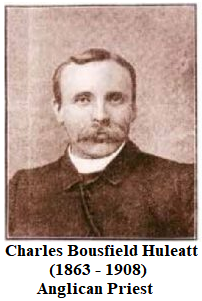
Charles, the second son of the Reverend Hugh and Cornelia Sophia Huleatt nee Bousfield was to lead an active and interesting life, until it ended suddenly and tragically at the age of 45.
He was born at Potters Bar, Hertfordshire in 1863 and educated at Magdalen College, Oxford where he read classics. After graduating, Charles went on to Wycliffe Hall, Dartford for two years of theological study until 1888 and then took Holy Orders.
After Curacies at Swansea and St Mark's Church, Broadwater Down, near Worthing, Sussex he travelled to Egypt as a Commonwealth and Continental Church Society Chaplain at the Luxor Hotel, where services were held for the tourists. Charles was also a missionary and preached at a mud-brick church in Luxor. (This church was swept away in a flood during 1910).
In 1892, Charles retumed to England and in the Marylebone district of London was married. No further details have been found of this marriage.
Back in Egypt, whilst visiting antique markets in Luxor in search of religious artefacts, he purchased three tiny fragments of papyrus, which contained Greek writing on both sides. Charles donated these to Magdalen College and arranged for his mother to send them to Oxford by recorded delivery. Two months later, having received no acknowledgement that they had arrived, he wrote to the college librarian. lt is understood that subsequent correspondence between the two has survived and is held in the college library/archives.
Initially, the fragments were believed to date from AD 180-200 and for nearly 100 years visitors to the college hardly noticed them in a butterfly display cabinet — next to Oscar Wilde's ring. They have since been re~examined and dated to AD 60, allegedly parts of a 1st century copy of the Gospel of St Matthew. Now called the ‘Magdalen Papyrus’ or ‘Jesus Papers’ they are said to be the most widely discussed fragments of the New Testament in the world.
By 1900 Charles was a widower and returned to England, where his second marriage took place. On 30th August at St Stephen's Church, Kensington he married Caroline Harriet Wylie, daughter of stockbroker Richard Wylie. His mother, Cornelia S. Huleatt was one of the witnesses. The certificate also records that an Arthur Cazalet, late Priest/vicar of Truro, also attended the wedding. Charles Bousfield Huleatt, ‘Clerk of Holy Orders‘, was aged 36 and his bride 37 years old. An earlier census records Caroline's place of birth as Bombay, East India (British subject). It is believed that soon after the wedding Charles and Caroline left for ltaly.
In 1901 they travelled to Messina, Sicily, where the Rev. Charles Huleatt was much involved with the Messina Football Club, becoming only the second ever Manager of the club and was also known to Captain the team on the field. ln 1904 Charles and the team played in the Whittaker Challenge Cup beating the Palermo team 3-2 and acquired their first trophy.
By the middle of 1908, Charles was again back in England, staying with his sister, Constance Sarah Tiighe and her family at Loosley House, Loosley Row, Buckinghamshire. During that visit, on 6th September at St John's Church, Lacey Green, he Baptized baby Constance Lillah GOMME, whose mother Ellen Nolan Gomme (nee Thrupp) and father Ralph Gomme, had both worked for the Tighe family at Loosley House, along with Constances' Grandmother, Elizabeth Thrupp as housekeeper/cook. Elizabeth had been connected with the Huleatt family for very many years. In 1871 she was employed in the Woolwich household of Charles’ parents — the Rev. Hugh Huleatt and his wife Cornelia and would have known Charles Bousfield Huleatt and his Siblings from their childhood.
Constance Lillah (to become Connie Baker) was told that she was the very last baby to be Baptized by the Rev. Charles Bousfield Huleatt before he returned to Sicily. (A copy of the Baptism entry for St John's, Lacey Green confirms this, records his signature and ‘Messina’ written below his name). The Vicar of St John's at that time was Rev. William Robson.
Back in Messina, Charles’ last game with the football club took place on 20th December, when the Messina team won 3-nil against Palermo. Just eight days later, at 5.20am on 28th December 1908, a devastating earthquake and tsunami occurred along the Straits of Messina, between the island of Sicily and mainland Italy. Messina was almost completely destroyed and took the lives of between 50,000 and 100,000 people. Amongst that number was the Rev. Charles Bousfleld Huleatt, together with his wife Caroline, their three children and a daughter from Charles’ first marriage.
Messina was in complete chaos and it took the men of the ‘Lancashire Cruiser‘, made up of English sailors, Four days to find the family buried under the ruins of their house... ...but it was too late, all had perished.
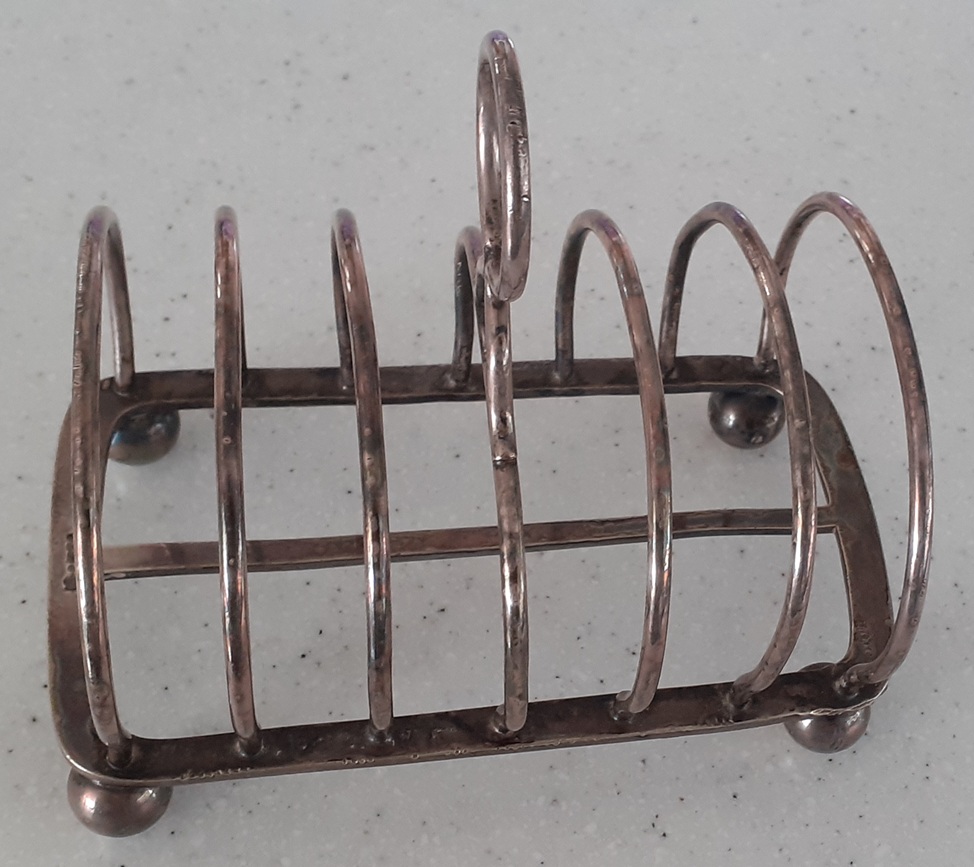
A large quantity of damaged silver items was retrieved from the middle of the house and shipped home to England. Charles’ sister, Constance Sarah Tighe decided to distribute the silver amongst the servants at Loosley House. Most items were eventually sold, but a silver toast rack still remains in the care of Elizabeth Thrupp's Granddaughter. Initially in a battered and crumpled condition, it was straightened out at Gomme's Forge.
Charles had not made a Will, but details of Administration appear in the Probate Index
| 1909 | Reverend Charles Bousfield Huleatt of 70 Via Torrente Trapani, Messina, Italy Clerk, died 28 December I908. Administration London 20 July 1909 to Constance Sarah Tighe (wife of Michael Augustus Tighe). Effects: £735. 8s. 10d resworn: £813. 18s. 10d. (£84K in 2025) |
Huleatt discovered the Magdalen papyrus and was also an early football player-manager of Messina Football Club. Natural disasters finally caught up with him
Michael Augustus Tighe was born at Templecombe, Somerset in 1861. By 1881 he was a Lieutenant in the 1st Derby Militia, and an article dated 16th October in ‘The Royal Irish Rifles’ reported that he had been appointed as a Probationer in the Indian Staff Corps.
He married Constance Sarah HULEATT (daughter of the Rev. Hugh Huleatt] about 1888 in Hyderabad, Deccan, India, where their twin daughters, Cornelia and Constance were born in 1890. Cornelia was named after her maternal Grandmother Cornelia Sophia Huleatt (nee Bousfield).
When the 1891 census was taken, they were back in England and living in Surrey:
The Cottage. Shalford. Hambledon near Guildford
| Michael A Tighe | Head | Mar. | 29 | Lt lndian Staff Corp | Templecombe, Somerset |
| Constance S " | wife | 28 | Aldershot Hants | ||
| Cornelia S " | dau. | 1 | Hyderabad India | ||
| Constance S " | dau | 1 | " | ||
| Georgina " | dau. | 3mth | Shalford Surrey | ||
| Mary A Crewe | Serv | 52 | Nurse | Bermondsey London | |
| Alfred Laker | " | Mar | 38 | Gardener | Sussex |
| Sarah " | " | 31 | Cook | Canterbury Surrey | |
| Ada A Simmonds | Un. | 14 | Nurse | Guildford Surrey | |
| Bessie Holmes | ,12 | Nurse | " |
In 1900 Constance Tighe's Uncle, the retired Reverend Alfred Bousfield, died and his niece eventually inherited Loosiey House, where their only son Roger Bousfield Tighe was born in 1903 and Baptised at St John's Church, Lacey Green on 28th March. By that time Michael Augustus Tighe was a Major in the Indian Army. Michael Tighe and family were away from home when the 1901 census was taken On 31st March.
The 1911 census records Michael and Constance Tighe and children were visiting Cornelia Sophia Huleatt (Constance's widowed mother) at her large New Forest mansion, Annersley House, in Bank near Lyndhurst, Hampshire. (In 1943, the property opened as a Dr Barnardo's Home.)
A Supplement to the ‘London Gazette’, dated 1st January 1919 regarding the Volunteer Force during the First World War, states:
'4th vol. Batalion, Oxford and Bucks Light Infantry — Lt/Col. Michael Augustus TlGHE (late 1st Bu., R.l.R., Indian Army) to command the battalion. 29th October 1918’.
When Lt. Col. Tighe finally retired from army service in India, he arranged for his Sepoy (Indian soldier} named Isma to return with him to Loosley House. During that time, Isma had his photograph taken, taught Ellen Nolan Thrupp how to cook curry dishes and, at his own request,
preferred to sleep in a tent in the large rear garden at Loosley House. However, Ismo oould not get used to the cold English weather and eventually returned home to India.
In 1921 Michael Tighe was appointed High Sheriff/Lord Lieutenant of Buckinghamshire - a title awarded annually.
He died in 1932: the Wills Index records:
Michael Augustus Tighe of Loosley House, Princes Risborough died 21st September 1932.
Probate (save and except settled land) London 8 November to Sir James Leigh-Wood, CMG., CB., KBE.,
and Dick Dalrymple Goldingham, Insurance Underwriter.
Effects: £983. 3s.
National Portrait Gallery
A portrait of Michael Augustus Tighe, Indian Army Officer, is held at the National Portrait Gallery, Trafalgar Square, London.
His widow, Constance, died ten years later. The Wills Index reveals she had moved from Loosley House:
Constance Sarah Tighe of Cadsden House, Monks Risborough, Bucklnghamshire
Widow, died 2nd August 1942.
Probate Llandudno 8 October to Roger Bousfield Tighe (son) Merchants Clerk and George Oldfield, Bankers Departmental Manager.
Effects:£5,096. Os. 10d.
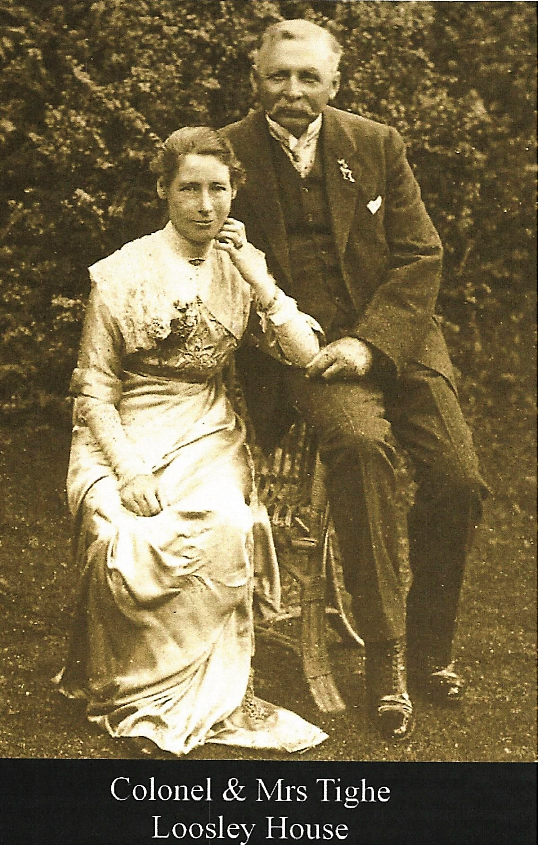
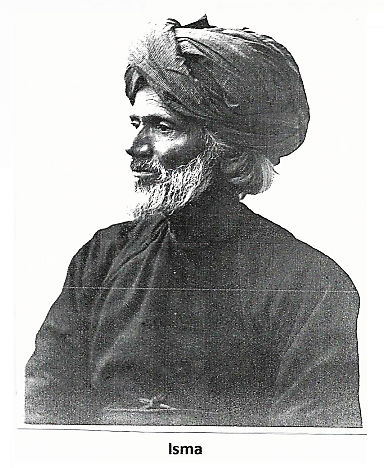
Isma came from India with Lt/Col Tighe to Loosley House.
He taught Ellen Nolan Gomme (nee Thrupp) - Connie Baker's mother - how to cook curry dishes.
Isma slept in a tent In the back garden of Loosley House
Couldn't get used to the English cold weather and eventually returned home in India.
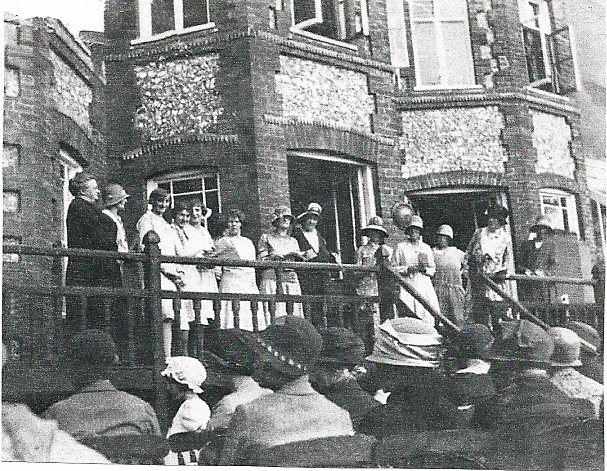
The inauguration ceremony was held in the rear gardens of Loosley House, then the home of Lt. Colonel Michael Tighe, Lord Lieutenant of Buckinghamshire and his wife, Constance.
Among the ladies on the verandah at Loosley House were Connie Baker (nee Gomme - 4th from left) and her mother (1st on the left).
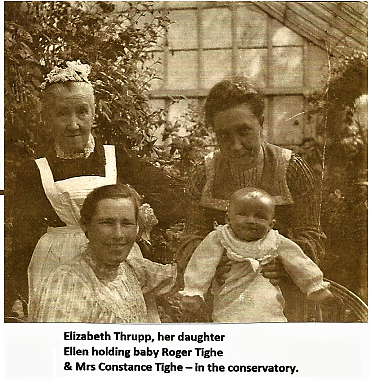
Elizabeth was born between 1830/34 in Illminster Somerset, the daughter of John Grabham, farmer. In her late teens or early twenties she moved to London where on 20th March 1853, at the Church of St John of Wapping, Middlesex, she married George William Broughton,, a weaver, son of a cabinet maker. At time of marrlage George was living at 8 Green Bank and Elizabeth at 1 Morgan Street, Commercial Road.
By 1871 Elizabeth was widowed and employed in the large household of the Chaplain of the Forces (Royal Artillery), Hugh Huleatt, his wlfe Cornelia and their children in the Officers Quarters, Woolwich Common. Elizabeth Broughton was then aged 37. Her friend and colleague, Lydia Baker was, later the same year, one of the witnesses at Elizabeth's second marriage.
On 16th November 1871 at St Mary Magdalene Church, Woolwich, Elizabeth married Royal Artillery Sergeant Charles Thrupp, who was born in Northern Ireland. The ceremony was conducted by the Chaplain Hugh Huleatt who, together wlth his wife, signed the register as witnesses: they were also to play an important part in Elizabeth‘s future.
Elizabeth and Charles’ daughter, Ellen Nolan Thrupp was born on 25th November 1876 and baptized at Mary Magdalene church in Woolwich on 22nd‘ December.
Charles was born about 1839 in Charlemont, County Armagh, Northern lreland. He joined the Royal Artillery at the age of 18 on 14th October, 1857. During that time he was awarded Five Good Conduct Badges and a silver medal. His physlcal description states that he was: 5ft 7“ of dark complexion, with brown hair and dark hazel eyes. In 1879 Charles, at his own request, was dlscharged from the Royal Artillery after 21 years, 226 days service.
The 1881 Census records that Charles (aged 40), wife Elizabeth (aged 47) and their 4 year old daughter Ellen Nolan was residing at 5 Lansdown Terrace, Lewisham, South London. Charles, occupation shown as 'Messenger'. Five years later he died at the age of 45.
Once again Elizabeth was widowed, but her former employers at the Royal Artillery Woolwich the Rev. Hugh Huleatt and his wife ensured she had secure employment and a home with Cornelias' brother, the retired Rev. Alfred Bousfield and his wife Emma at Loosley House, Loosley Row, Buckinghamshire. The 1891 Census records Elizabeth working there as a cook. The only other occupants at the time the Census was taken on 5th April were Florence Parker, 20 years old, a housemaid and Charlott: Potter, aged 18 - a parlourmaid.
In 1911, when the census was taken, Elizabeth gave her age as 8O and was still employed at Loosley House as Housekeeper. The only other people recorded there at that time were Hettie Gooden, a 26 year old Parlourmaid and Nellie Rutland, aged 20 worklng as a Housemaid. At one time, Madge Gomme (sister of Hilda Gomme, the postlady was also employed at Loosley House as a Parlourmaid. The Tighe famlly were away when the Census was taken on 2nd April.
Elizabeth Thrupp died in 1915, aged 85 and was burried at St John's Church, Lacey Green.
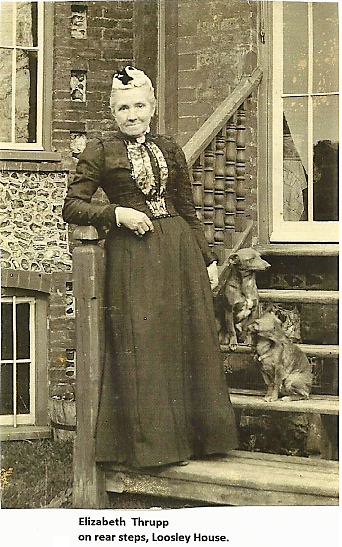
An Act of Parliament in the UK -The National Registration Act, 1939. was introduced as an emergency measure at the outbreak of World War 2, Royal assent was given on 5th September 1939. A massive administrative task was underway — the taking of the registration was one of
the most important documents of the 20th century. The initial reglstration was used to produce Identity Cards, organise rationing and keep a check on where the population was residing. Forms were issued to more than 41 million people and later the information was also used in the founding of the National Health Service.
The 1931 Census was destroyed in an air raid during World War 2 at Hayes, Middlesex where the Census papers were deposited. A 1941 Census was never taken, so the 1939 Register is invaluable for research purposes.
Loosley House, Lower Road, Loosley Row
The house, or part of it, was used at the start of World War 2 for evacuees from the North Kensington Nursery School. Below are details from the 1939 register. Many of the names have been ‘blacked out’ with the words ‘This record is officially closed‘. The modern term is 'redacted'.
The remaining entries list staff and some of the children at the school In Loosley Row. It would have been a peaceful haven for all, with a large garden and well away from the Blitz on London. Only names, dates of birth and description of work (where applicable) were recorded. The owners of the house at that time were Arthur and Joyce Waite - the first names on the list.
| Staff | Arthur Waite Joyce Olive G Waite Rosemary J. Hewett Beryl Hankin Hilda M. Rayle (nee Smith) Norah B Gibbs Ann Saunders [nee Hampton] Ann Sylvia Hardy Eileen M Marriett Edward G. Dell Margaret Savage Annie Tomkins |
13.7.1914 14.12.1900 3.4.1911 12.6.1914 24.2.1914 10. 11.1916 3.7.1916 8.4.1905 12.7.1924 29.11.1912 24.3.1904 5.6.1877 |
lnspector af Schools lnspector af Schools Nursery School Superintendent Nursery School Assistant Nursery School Assistant Nursery School Teacher Nursery Assistant (Probationer) Cook Housemaid - Nursery Gardener Nursery School Teacher Domestic duties |
|---|
It is understood that May Mercer was also later an Assistant at the North Kensington Nursery School, Loosley House. Kathleen May Mercer came from Banstead, Surrey and stayed in Lacey Green for the remainder of her life. During her time in this area she met a 'local lad’, Bert Ralph George Dell from Hickman’s Stores, Main Road, Lacey Green. May was a bridesmaid at his brother's wedding in 1954 and Bert was the Best Man.
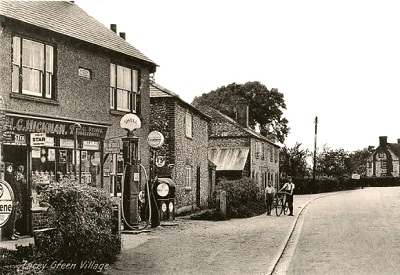 On 4th August 1956 Bert and May were married at St John's Church, Lacey Green. For many years both ran the grocery shop/general store and were much admired by the local community for the efficient and friendly way they conducted business. The shop was also a favourite ‘meeting place’ for many villagers, especially the elderly living alone.
The price on the pump appears to read that the petrol was 1s. 5d a gallon!
On 4th August 1956 Bert and May were married at St John's Church, Lacey Green. For many years both ran the grocery shop/general store and were much admired by the local community for the efficient and friendly way they conducted business. The shop was also a favourite ‘meeting place’ for many villagers, especially the elderly living alone.
The price on the pump appears to read that the petrol was 1s. 5d a gallon!
Children
The majority of entries for the names of children have also been ‘blacked out’, below are those remaining with their dates of birth:
| Alice Blaxall Henry Batchelor Gloria Iohnson ]ean Melville William Moore Edwin Newton Patricia Pittharn Frank Seidler John Wheeler |
3.10.1937 3.2.1936 7.7.1936 2.4.1936 27.2.1937 1936 1.4.1937 24.1.1936 14.9.1938 |
Another episode in the long and varied history of Loosley House and the people who resided there over the years.
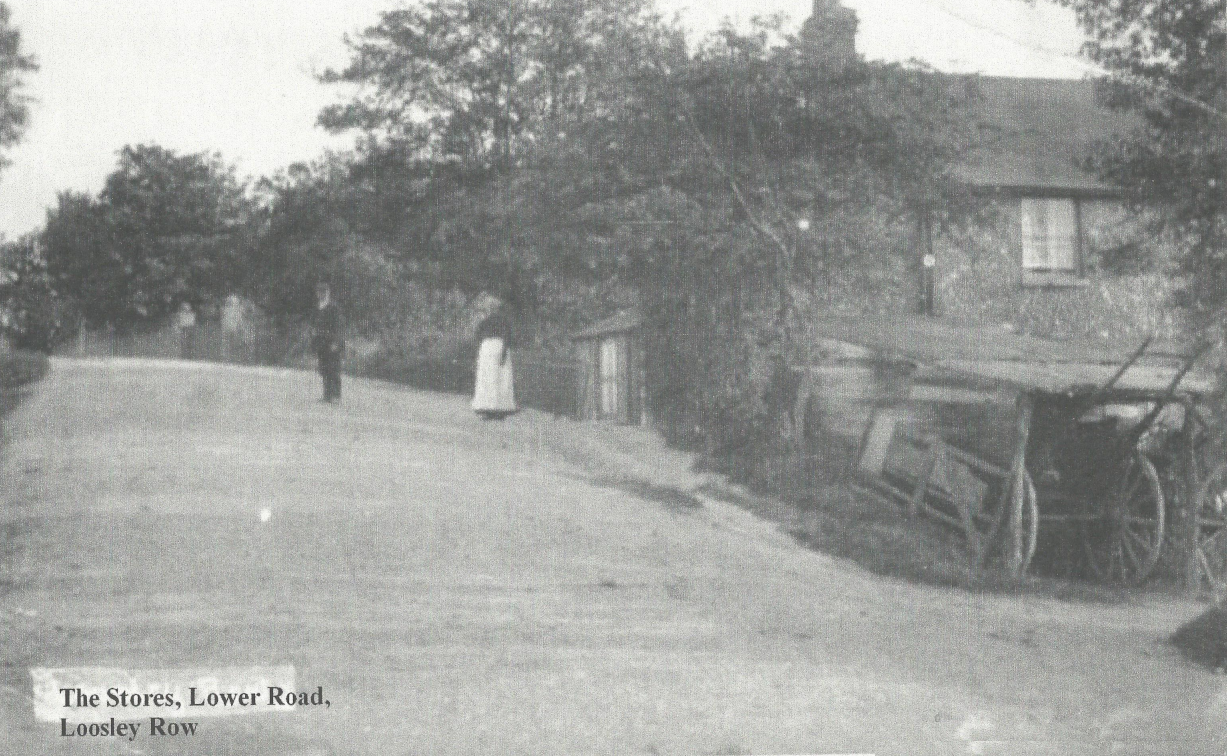
In 1864, the house, bread oven and shop was built for a baker, Henry Janes, in Lower Road, Loosley Row, where he lived with his wife Mary (nee Ginger) and family. From there he baked and sold bread until his new Bakehouse was erected in Lacey Green. The latter stood at the corner of Goodacres Lane, Main Road and was sadly demolished some years ago.
Henry Janes died on 29th July 1889. He had been a shrewd, hardworking tradesman and provided comfortably for his daughters and son Hezekiah, to whom he left the Lacey Green Bakery. To his daughter, Annie he bequeathed the shop in Loosley Row.
Annie was married to George Floyd and they had three daughters, Daisy, Annie and Emily. They could remember what the shop was like during the early 1900's. As well as the usual groceries and provisions, sweets and tobacco, they sold some hardware such as coal shovels and also brooms, besoms (broom made from twigs), tea pots and other crockery. Haberdashery items were also on sale -- pins, needles, tape, ribbons, cotton and darning wool, which would have saved many a local inhabitant from a trip into Princes Risborough or High Wycombe.
Annie particularly remembered her mother's insistence on great attention being paid to the window displays. It was the girls' duty to dress the windows and also to turn everything out at regular intervals so that they could be cleaned and polished.
The window nearest the Baptist Chapel had a number of shelves, which were always loaded with rows of large glass jars of sweets. The display in the other window would be varied according to the season. In the Spring there would be a special arrangement of garden seeds from John Walker, Nurserymen and Seedsmen of Thame for whom George Floyd had secured the agency. At Christmas a decorative show of toys and decorations would attract young and old customers alike.
The shop windows had wooden shutters, which still remain to this day.
George Floyd was apparently a 'go ahead chap' and soon developed other sidelines, in conjunction with the shop. He kept and fattened pigs and also bought in fat pigs for slaughter. The photograph shows George Floyd in the middle of the ghastly ritual of killing a pig. Needless to say, it was his wife who cured the bacon and the hams, then prepared the lard, which was sold in the shop.

He then bought a horse and cart and started selling coal, collecting it from the goods yard at Princes Risborough Railway Station.
Later he again 'branched out', bought a second horse and cart, employed a Harry Gomme as driver and commenced a Carriers business. Every Friday (market day) he would collect fish and newspapers from High Wycombe and parcels to and from both railway stations.
He then undertook outside catering for such occasions as the Chapel outings. A late resident of Loosley Row recalled serving tea, lemonade, ginger beer, cakes and buns from trestle tables at Whiteleaf - a popular place for outings.
Always a keen gardener, George Floyd at one time had been Head Gardener to 'Squire' Forrest at Grymsdyke, Lacey Green. He was often in demand to judge the allotments at Longwick. Added to the above, George was also Secretary to two local slate clubs (an early form of savings clubs) at The Sprat and The Whip public houses.
George Floyd's youngest daughter Emily married a farmer's son, Arthur W. Harvey. Arthur was born in 1902 at Bryants Bottom, one of a large family and his father occupied a number of farms in the area. lt was from Lodge Hill Farm, Saunderton that Arthur left to marry Emily Floyd in 1930. He moved into the shop, but continued to work as a builder for White Brothers, High Wycombe. When his father-in-law George Floyd died, Arthur Harvey took over the coal and Carriers business.
This was when the name of the shop changed to Harvey's Stores. The name board 'A.W. HARVEY' was on the brickwork above the grey slate roof of the shop below. (Although now removed the evidence it was there can still be seen in 2024) He added a Sub-Post Office, whilst his wife Emily and her mother looked after the shop.
At the outbreak of the 2nd World War, Arthur took a job in an aircraft factory and after the war was employed at the then named Bomber Command, Walters Ash, full time until he was 65, then part-time to the age of 70.
Arthur and Emily Harvey's daughter, Edna, like her mother and grandmother before her, worked in the shop. In 1961 when her mother died, Edna took over with some help from her father and her husband Donald Bailey. So Edna was kept very busy with husband, son and ageing father to care for, in addition to the shop.
In 1970 Edna decided to give up the business, had a 'Sale', and it closed for good. Thus ending more than a century of invaluable service to the two villages.
Arthur Harvey lived on with his daughter, son-in-law and Grandson until his death, aged 77 in August 1980.
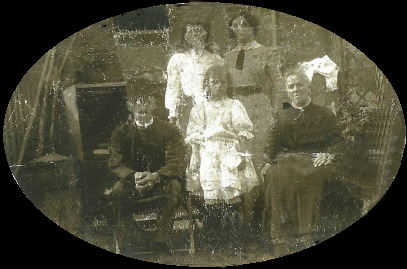
George and Annie Floyd (nee Janes] and their daughters Annie, Daisy and Emily
This the Last Will and Testament of me, Henry Janes of Lacey Green in the Parish of Princes Risborough, in the Country of Buckinghamshire.
I hereby revoke all Wills made by me at any time hereforeto made. I appoint my son, Hezekiah Janes and my daughter Annie Janes to be my Executors and direct that all my just Debts and Funeral and Testmentary Expenses shall be paid as soon as conveniently may be after my decease.
I give and devise and bequeath unto my wife Mary Janes the sum of one hundred pounds. The amount for which my life is assured in the Prudential Assurance office at Princes Rlsborough for her sole use and benefit.
Also to my daughter Bethia Saunders the sum of one hundred and fifty pounds. And as to the residue and remainder of all my Real and Personal Estate consisting of the Bakery, dwelling house and outbuildings with all the adjoining land at Lacey Green amounting to about sixteen acres of land more or less and also the cottages and gardens at Loosley Row at present in possession of and occupied by the tenants Frederick Lacey and William Adams. Also the shop and dwelling house and garden occupied by Thomas Harvey also at Loosley Row. l give, devise and bequeath to my son Hezekiah Janes and to my daughter Annie Janes to be equally divided to them share and share alike with all, every other possession of money or property I may die possessed of.
In witness whereof I the said Henry Janes have to this my Last Will and Testament set my hand this twenty third day of July in the year of our Lord one thousand eight hundred and eighty nine.
Signed by the Testator and acknowledged by him to be his Last Will and Testament in the presence of us present at the same time who at his request in his presence and in the presence of each other have subscribed our names as witnesses.
William F. Kelly
Elisa Kelly
On a separate undated piece of paper was reference to:
The cottages in Loosley Row in the occupation of Martha Hopps, Elizabeth Dormer, Daniel Ginger and Mrs Ginger and then of William Adams, with a piece of arable land adjoining and long used as a garden to such oottage or tenement and also all that one cottage lately erected by the said H. Janes on garden belonging to him adjoining the cottage then in occupation of William Taylor.
And also all that piece of land situated at Loosley Row aforesaid containing 1 rod, little more or less being part and north end of allotment one acre at Loosley Row aforesaid containing 2 rods and ten perches by award made on Enclosure of open and common fields of Princes Risborough aforesaid allotted to James Crook.....by way or passage leading from Wycombe Road to a Chapel there, together with home and buildings erected by the said Henry Janes.
It is not known for sure when the house, now known as Loosley Dene, was built. One theory suggests the site once contained two or more cottages dating from the 1840's, which belonged to the Baptist Chapel next door. lf not demolished, these were possibly altered and enlarged over the years to form the basis of the current house.
The house was not specifically named: residents appeared in census returns and directories merely as living at 'Loosley Hill' or 'crossroads, Loosley Row'.
When Doctor S.B. Watson moved into the house with his family about 1869, it was the beginning of occupation by members of the Watson family for 60 years.
Benjamin Seth Watson was born in Southwark, London about 1811 and studied at St John's College, Oxford, later becoming one of the Physicians at Oxford Hospital.
In 1840. he married Isabella Maria Goolden: their two daughters, Mary and Penelope were subsequently born in Maidenhead, Berkshire. A son, Thomas Henry Gordon was born around 1848 St George, Hanover Square, London.
By I861, Seth, his wife and three children were residing at Hall Place, Wycombe End, Beaconsfield, which also included a private school. Some of the pupils were Seth's Nieces and Nephews, whose places of birth are recorded in the 1861 census as 'East India, British Subjects'. There were four other pupils originating from various parts of England. The household was considerably large: it included a Governess, her Assistant, Semptress, Cook, two Housemaids, Coachman and a Garden Boy!
A Directory for 1864 indicates that Doctor Watson was working as a Physician from a property in the High Street, Beaconsfield. By 1869, he is recorded at Loosley Row.
In 1871 he was temporarily staying in Lincolnshire, attending as Physician to the Earl of Lindsey - Peer of the Realm, George Augustus Bertie at Uppington House.
Meanwhile, Dr Watson's daughter, Penelope was visiting friends in Paddington, but his wife, Isabella and daughter Mary, aged 27, were resident at 'Loosley Hill'. The household also included various visitors and Boarders, plus a Cook, Nurse and Housemaid.
| Isabella Maria Watson | Wife | Mar. | 61 Physicians wife | Maidenhead, Berks |
| Mary A.S. Watson | Dau. | Un. | 27 Physicians wife | Maidenhead, Berks |
| Eleanor Seward | Boarder | Widow | 37 Member of Council | St Helena |
| Mary I Poulter | Visitor | Mar. | 58 Clergyman's wife | London |
| David Beames | Boarder | 8 Magistrate's son | East Indies | |
| Frederick Beams | Boarder | 7 Magistrate's son | East Indies | |
| Rupert Beams | Boarder | 6 Magistrate's son | East Indies | |
| Ann Underwood | Servant | Un. | 31 Housemaid | Hulcot, Bucks |
| Mary Ann Shaw | Servant | Un. | Cook | Maidenhead, Berks |
| Ann Dwight | Servant | Un. | Nurse | Uxbridge, Middx. |
(Mary PouIter above was visiting her future in-laws. A year later Mary Watson married Mrs Poulter's son -details below).
Living next door or nearby was a Charles Collins and his family. Employed as a gardener and wife, Ann as Laundress, they were probably working for the Watson family.
At St John's Church, Lacey Green on 24th July 1872 Mary Ann Spencer Watson, Spinster of Loosley Row, daughter of Seth B. Watson, MD, married Reginald Clifford Poulter, Bachelor, Gentleman, BA of 22 Alfred Street, Bedford Square, London, son of James Poullter, Clerk MA.

A year later, Isabella Watson died at the age of 63. She was buried in St. John's Churchyard Lacey Green on 26 February 1873.
On 11th October the same year, an auction notice appeared in the Bucks Herald:
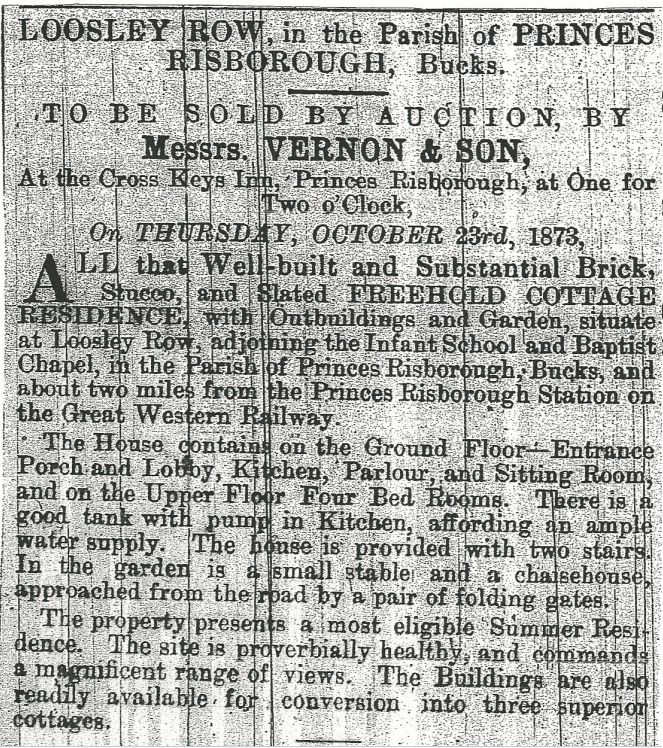
The property for whatever reason, was not sold and Dr. Watson continued to occupy the house.
In 1881, with daughter Penelope, he, is recorded visiting friends at 10 St. James Terrace, Paddington.
Banns were called on three occasions - the last on 29th March 1885 for the marriage of Thomas Henry Gordon Watson, Bachelor of this Parish to Ruth Rusher, Spinster of the Parish of Bloomsbury, Middlesex.

Copy of entry in Marriage Register of Parish Church of St. George, Bloomsbury, Middlesex
At about 7.30pm on Friday, 15th May I835, Dr Seth Watson saw his neighbour Thomas Harvey with his son's horse and expressed his intention of going for a ride. Tom saddled up the horse and led it and the rider to the Firr Plantation. Dr Watson asked to have the reins so that he might have a canter. Tom asked if he was capable and the rider replied he was.
The horse started to canter and Tom ran by its side for 40 or 50 yards, when suddenly the horse stumbled and Dr Watson was thrown over its neck. Tom ran to stop the horse, but the doctor had his foot caught in the stirrup and was dragged for about 20 yards. Mr Thomas Warren, Surgeon of Princes Risborough was called but tragically, Dr Watson was declared dead. At the Inquest, which was held at The Sprat public house, a verdict of Accidental Death was recorded.
(Precis of local newspaper report).
Many tributes were paid to Dr Watson who, it was reported, had resided in this neighbourhood for a number of years and was held in very high esteem by all who knew him for his genial manner and kindness of heart.
Watson
Seth Benjamin
Personal Estate
£479 8s 9d (£53k in 2025)
29 August. Administration of the Personal Estate of Seth Benjamin Watson late, of Loosley, Princes Risborough in the County of Buckingham Widower who died 15 May 1885 at Loosley, was granted at the Principal Registry to the Reverend Thomas Henry Gordon Watson of Loosley Clerk the Son and one of the Next of Kin.
The burial register of St John's Church, Lacey Green records:
Seth Benjamin Watson buried 21st May 1885 age 74 of Loosley Row.
'.....Doctor S. B. Watson, a man of no ordinary character was a member of St John's College, Oxford and took his degree of Doctor of Medicine in that University. He was for some time Physician to the Radcliffe Infirmary and marked his tenure of office there by the discontinuance of the practice of bleeding in the treatment of disease. He afterwards resided and practised several years in London, but for the last twenty-five years his home had been in Buckinghamshire. He was a man of great intellectual power and attainments and his intimate friends feel that by his death a light has been quenched: an ever-fresh spring of original thought, humour and practical wisdom has been closed to them.
An unpublished MSS by Samuel Taylor Coleridge on 'The Theory of Life' was edited and published by Dr Watson. A translation from an Italian work on the cholera at Malta, also a translation in verse of the Promethiens Vinctus, were among his publications.
He could never be persuaded to publish any more important original work of his own. But amongst his friends are scattered sonnets and other poems, which are cherished by them as amongst the most beautiful things in the English language. No man shunned more than Dr Watson a reputation for piety, yet upon few men had the real power of religion a stronger and more constant influence. He was a devoted son of the Church of England and acted as a lay member of the Oxford Diocesan Conference and served for some time as a lay reader at Longwick in the Parish of Princes Risborough. His influence for good in the inner life of those with whom he was brought into contact is not to be measured. By his own simple, self-denying life, and his kindness and devotion to those in need, he has won the heartfelt respect and affection of his poorer neighbours at Loosley Row and Lacey Green, amongst whom he spent the last years of his life and amongst whom, he died.
He left no Will but Administration of his personal estate was granted at the Principal Registry on 29th August to the Reverend Thomas Henry Gordon Watson of Loosley Row, Clerk, the son and one of the next of kin. The value of his estate was £479. 8s. 9d.
In 1891 Penelope A.S. Watson was residing at the family home in Loosley Row. She had one domestic servant livlng in - Mary Ann Floyd, unmarried aged 55.
ext door was Thomas Harvey's Grocer’s Shop (the little shuttered-window cottage which still remains). With him was his wife Ellen and daughter Susan, a 10 year old scholar.
y 1901 clrcumstances remained the same for Penelope Watson. She lived alone, apart from one servant - Kate Harvey. The last census currently available is for 1911, which records:
Loosley Hill
| Penelope Anne Statter Watson | Head | Single | 66 | Private means |
| Mary Ann Fowler | Serv. | Single | 55 | General domestic servant |
The census also states that there were seven rooms in the property.
Older Loosley Row residents recalled that as an elderly lady, Miss Watson kept a number of goats in the Field where the water pump is situated. Sometimes the goats would escape and cause havoc in the locality until they were rounded up.
Penelope Watson died on 4th June 1929. She left a Will with the index details as follows:-
WATSON Penelope Ann Statter of Loosley Hill, Princes Risborough, Buckinghamshire
Spinster, died 4 June 1929.
Probate London 18 August to Edward Clifford Watson, Commander Royal Navy and Leonard Burton Watson, Solicitor.
Effects: £3,674. 16s. 4d.
The above named were possibly Penelope Watson’s nephews (or Great Nephews).
Directories for 1931 — 1939 record the owner of the house as Arthur Crofton-Attkins. The address at that time shown as Crossroads, Loosley Row.
By 1945 Robert and Margaret H. Floss lived there.
The electoral register for 1953-4 recorded the ocoupants as Martin and Ruby Ann Longley and it appears it was about that time, the house was named ‘Loosley Dene’.
By 1957-58, Martin Longley was still recorded at the address, along with a Dorothy Longley.
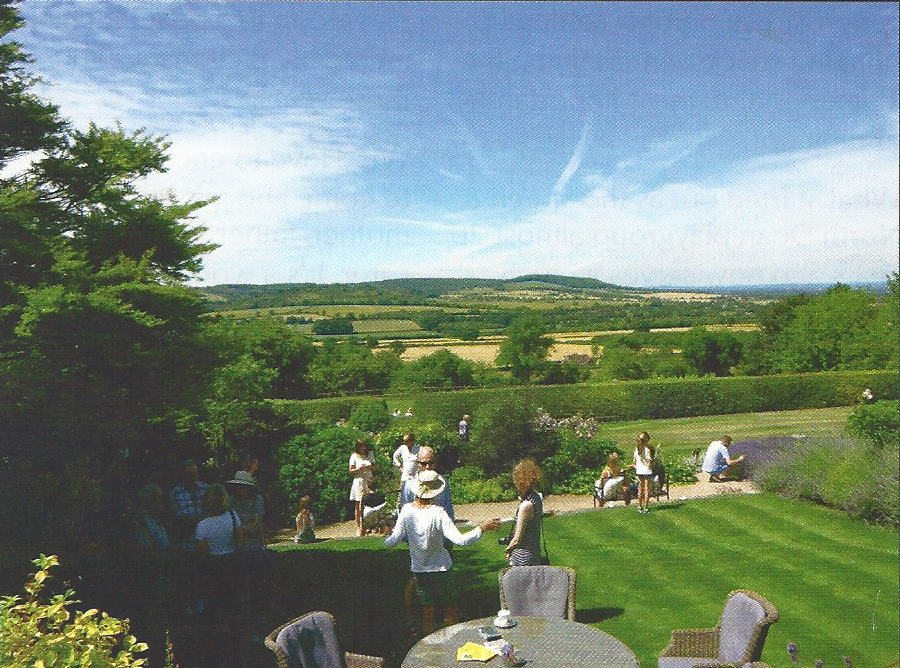
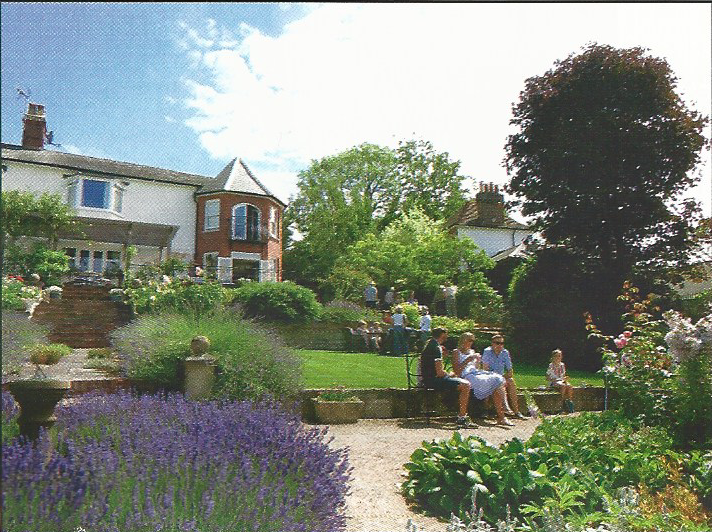
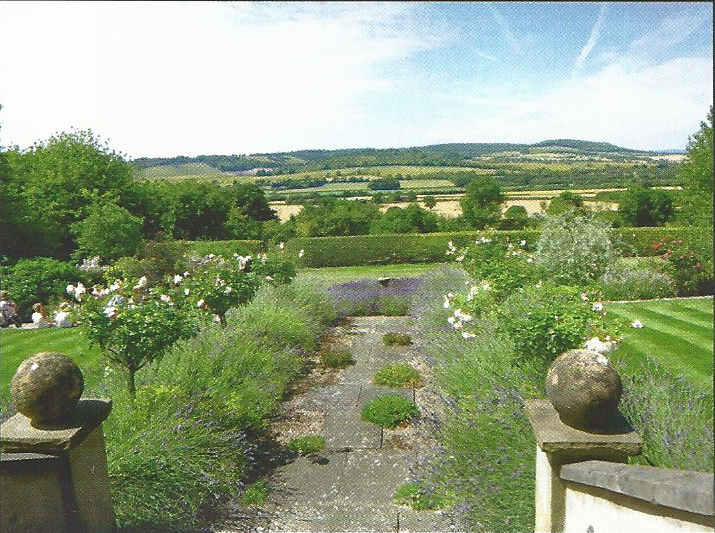

Generations of the WARD family of Carpenters stretch far back into the 1700 's in Speen and, later, Loosley Row.
Jesse WARD born in 1799 at Speen was the son of Joseph, a carpenter. When Jesse married a Loosley Row girl in I827 he moved to our village: a carpenter by trade, he also later opened the first Post Office in his cottage where he, and subsequent generations of his family resided and worked over the years.
Almost a hundred years after Jesse 's birth, his Grandson's Cecil and Albert also continued working as Carpenters. By 1881, with their father John Ward, all were employed at Thomas Glenister's furniture factory in High Wycombe. The family resided in a cottage at Temple End nearby. Although not yet researched. it is possible that there are still members of this particular branch of the Ward family working as carpenters 'out there' somewhere.
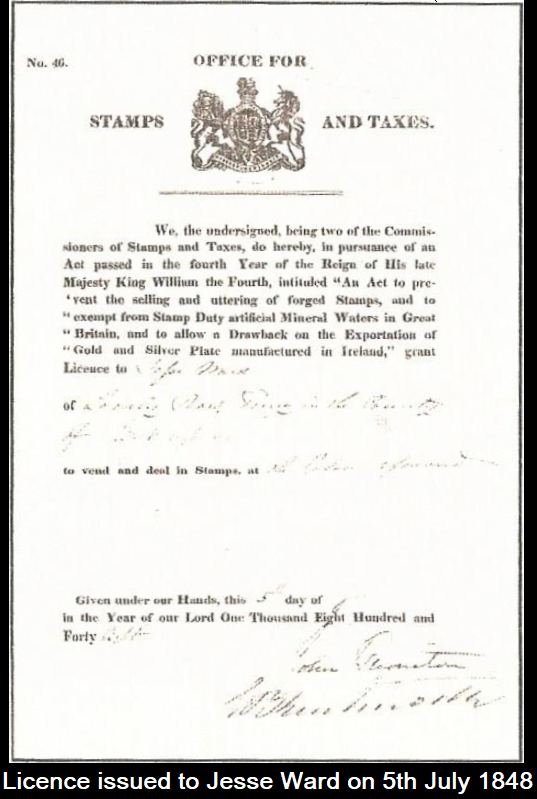
A Licence to sell postage stamps was granted on 5th July 1848 to Jesse Ward of Loosley Row, Tring. (The address including ‘Tring’ arose from the fact that this was the postal town for the district until at least 1910.)
At that time mail arrived in Princes Risborough from Tring by mail cart at 7.0am each morning, with the exception of Monday, when it was delayed until 10.45am. Outgoing mail was despatched every evening at 7.0pm.
The Licence was connected with an Act passed in the fourth year of the reign of King William IV to:
‘prevent the selling and uttering of forged stamps and to exempt from Stamp Duty artificial Mineral Waters in Great Britain and to allow a drawback on the exportation of Gold and Silver plate manufactured in Ireland’.
It is believed that Loosley Row Post Office was one of the earliest established in the country. In a Trade Directory for 1853 Jesse Ward is recorded as Postmaster, grocer, shopkeeper and carpenter. After Jesse's death he was succeeded by his son, Alfred, who continued as Postmaster until his death in 1906, when his daughter Mary Ann Ward, known as ‘Polly, took over the role as Postmistress, with one female assistant. After she married Henry Allen in 1913, he became Postmaster and Stationer, selling postcards of Looslev Row.
The Ward family originated from Speen, where Jesse was born on 9th August 1799, son of Joseph and Rebecca Ward, Carpenter.
On 12th March 1827 at St Mary's Church, Princes Risborough: Jesse Ward 'bachelor of Speen' married Ruth Eggleton, 'spinster of Loosley Row '. The witnesses were Levi Ward and Ann Parslow. There is an additional entry stating 'with consent of parents'. Ruth was the daughter of Thomas and Mary Eggleton, baker of Loosley Row. She was born on 1st November 1810 and therefore only about 16 when married.
After their wedding, the couple resided at Loosley Row and 'following in his father's footsteps', Jesse was employed as a carpenter. Their home was the cottage, later to become the Post Office and Grocer's shop in Lower Road, (situated just below where 'Green Pastures' now stands).
For some unknown reason, Jesse and Ruth were not baptized until adulthood. On 9th December 1838, together with two of their sons and daughter, all five were Christened on the same day at St. Mary's Church, Princes Risborough:-
Sons Alfred (born 24.1.1827) Jabez (born 3.9.1832) and daughter Mary Anne (born 28.4.1834) (Jesse and Ruth also had another son John who was born about 1839, but there is no trace of his Baptism in the Parish Register transcripts).
A Trade Directory of 1847 shows Jesse Ward as Carpenter & Shopkeeper at Loosley Row. By 1854, the premises also incorporated a Post Office. Jesse continued working as carpenter and joiner, whilst his wife Ruth was in charge of the Post Office and Stores until her death in 1848.
| Jesse Ward | Head | Widower | 57 | Carpenter (born: Speen) |
| Alfred Ward | Son | Unmar. | 23 | Carpenter |
| Jabez Ward | Son | Unmar. | 18 | Carpenter |
| Mary Ann Ward | Dau. | Unmar. | 16 | Housekeeper |
| John Ward | Son | 2 |
On 18th August 1851, Jesse and Ruth's son Jabez was married:
At St John 's Church, Lacey Green
Jabez WARD. Minor, Bachelor, Carpenter of Loosley Row, son of Jesse Ward, Carpenter
to
Amelia PHILBEY, full age, Spinster of Loosley Row, daughter of Joseph Philbey Gentleman's Servant.
Witnesses:
Abel Dell; Alfred Ward; Mary Ward; Mary A Burgess and James Maberly.
The wedding was conducted by the Reverend William Burgess who, at that time, resided at 'Loosley House' before moving with his family to Lacey Green Parsonage. His wife Mary Anne sometimes acted as a witness to marriages. Amelia's father, Joseph Philbey - 'Gentleman's Servant' was most likely to have been employed at 'Loosley House'.
The above was actually the very first marriage to take place at St John's Church, Lacey Green. Prior to that villagers from the Upper Hamlets (Loosley Row, Lacey Green and Speen) had to travel to St Mary's Church, Princes Risborough for weddings.
In 1858 Alfred Ward married Jane Maberly. The original 1861 census indicates that they were residing near to Alfred's father, Jesse:
| Alfred Ward | Head | Mar. | 33 | Carpenter and Joiner |
| Jane Ward | Wife | 38 | Lacemaker |
A small beige embossed book with brass clasps
(Ref: D 114/58 - Held in the Record Office, Aylesbury)
The entries are a mixture of personal details and accounts regarding Alfred's occupation as a Carpenter. Although, one of the first entries was a recipe for making Ginger Beer.
| 1855 | Dimensions for a sheep trough 10 feet long and sheep cribs. Joseph HAWES debtor to A. WARD for sawing stuff for Chapel two shillings. |
|
| 1856 | "On Wednesday February 20th 1856 about 3 o'clock in the afternoon, I lost my brother Jabez after a very short, but severe, illness borne with Christian patience". |
|
| 1857 | Solomon GINGER, Debtor to Alfred WARD Feb.14 for new Tent Bedsteod £1. 18s; Deal table 10 shillings and Washing tray 5 shillings and sixpence. |
|
| 1858 | New desk for The Oddfellows Club. Pictures frames for Ann DELL. Cucumber frames with two lights for Mr Thomas GOMM. |
|
1859 | Chest of drawers for Abel DELL £2. 5s.0d. |
|
1860 | Clothes Box for Mary DORMER of Bottomfield. |
(The next few years contain many entries in relation to work carried out for the Methodist Chapel, Lacey Green).
ln December 1872, Alfred WARD was preparing for his wedding and the following entries were made:
| 1872 | "On December 28 one and half days self papering own room. December 31st Wedding Day. |
|
| 1873 | No work - wedding week". (This was the last entry in Alfred WARD's ledger). |
Ten years later in I871, they were still occupying the same property - Alfred now aged 43 and Jane 48.
Staying with them at this time was a Nephew, Abel Dell, aged 13, employed as an agricultural labourer. This lad was the Grandson of Jesse Ward. In 1859, Jesse's daughter Mary Ann had married one Abel Dell, a Shepherd. Later in 1871, at the age of 49 years, Alfred Ward's wife Jane died. A year later, he married again:
At St John's Church. Lacey Green
On 31st December 1872
| Alfred Ward | 45 | Widower | Carpenter of Loosley Row, son of Jesse Ward, Carpenter to |
| Elizabeth Steel | 39 | Spinster | of Lacey Green, daughter of John Steel (deceased) Miller. |
Witnesses: James Chilton; Jane Lacey; Mary Anne Chilton; George Cheshire
(Elizabeth's father had been a Miller at Lacey Green Windmill).| Jesse Ward | Head | Widower | 81 | Grocer & Post Master |
| Alfred Ward | Son | Married | 53 | Carpenter |
| Elizabeth Ward | dau.-in-law | Married | 47 | Assistant in shop |
| Mary Ann Ward | G/Dau. | 7 | Scholar |
Five months later, on 10th September, Jesse Ward died. He was buried on the 15th in the churchyard at St John's, Lacey Green. He had made a Last Will & Testament:-
The Will of Jesse Ward late of Loosley Row in the Parish of Princes Risborough in the County of Buckingham, Carpenter and Grocer, who died 10th September 1881 at Loosley Row was Proved at Oxford by Alfred Ward of Loosley Row, Carpenter, the son, and Job Pearce of High Wycombe in the said County, Gentleman, the Executors.
Personal Estate: £501. 12s. 6d.
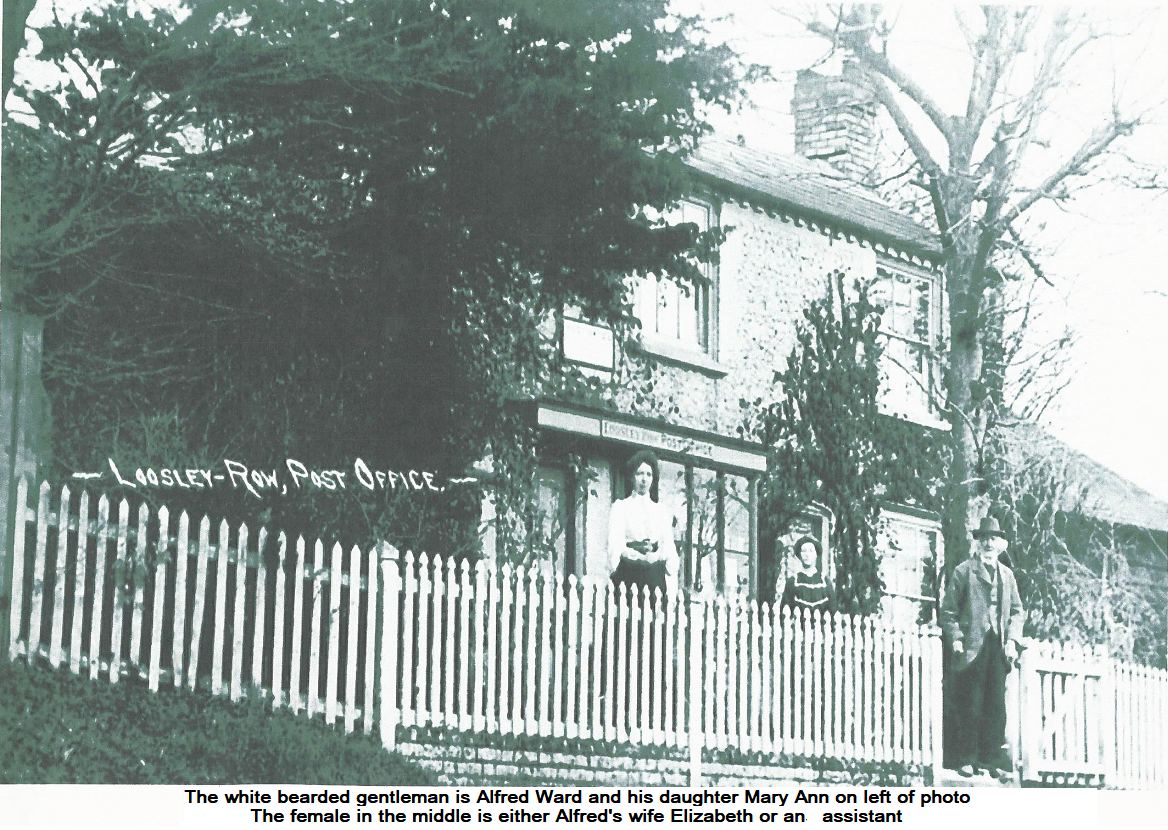
Alfred and his wife then took over the shop and Post Office, although Alfred also retained his occupation and, according to numerous reports, was a very accomplished and highly skilled Carpenter. One such example of his work is mentioned below. A large wooden building next to the Post Office was the carpenters' workshop, where coffins were made, as well as general joinery. Alfred additionally made bespoke pieces of simple everyday furniture.
ln 1887 when Queen Victoria was celebrating her Golden Jubilee women and girls from Loosley Row, Lacey Green and Speen produced some of their Beadwork as a gift. Alfred Ward made the Beechwood casket to contain the items. A copy of an article which appeared in the 'Bucks Herald' newspaper dated 18"' May 1887 is reproduced on the following page, together with a list of the Loosley Row Bead-workers in 1891 - many of whom would have been involved in making the beadwork gift. The article also describes the intricate work involved by Alfred Ward when constructing the wooden casket.
| Alfred Ward | Head | Mar. | 63 | Carpenter |
| Elizabeth Ward | wife | 57 | Grocer | |
| Mary Ann Ward | Dau. | 14 | ||
| Annie Cheshire | Serv. | Unm. | 24 | Domestic Servant |
| Alfred Ward | Head | Mar. | 73 | Grocer and Carpenter |
| Elizabeth Ward | wife | 67 | ||
| Mary Ann Ward | Dau. | Unm. | 24 | Assistant in Grocer's Shop |
Elizabeth ('Betsy') Ward died in 1904 aged 70 and was buried on 6th January in St John's Churchyard. Just two years later, Alfred passed away aged 76 on 7th August 1906. He left a Will and details from the index are:
Alfred Ward of Loosley Row, Princes Risborough, Buckinghamshire, retired Carpenter and Grocer died 7.8.1906. Probate Oxford 5 October to Mary Ann Ward. Effects: £1,378. 172. 11d.
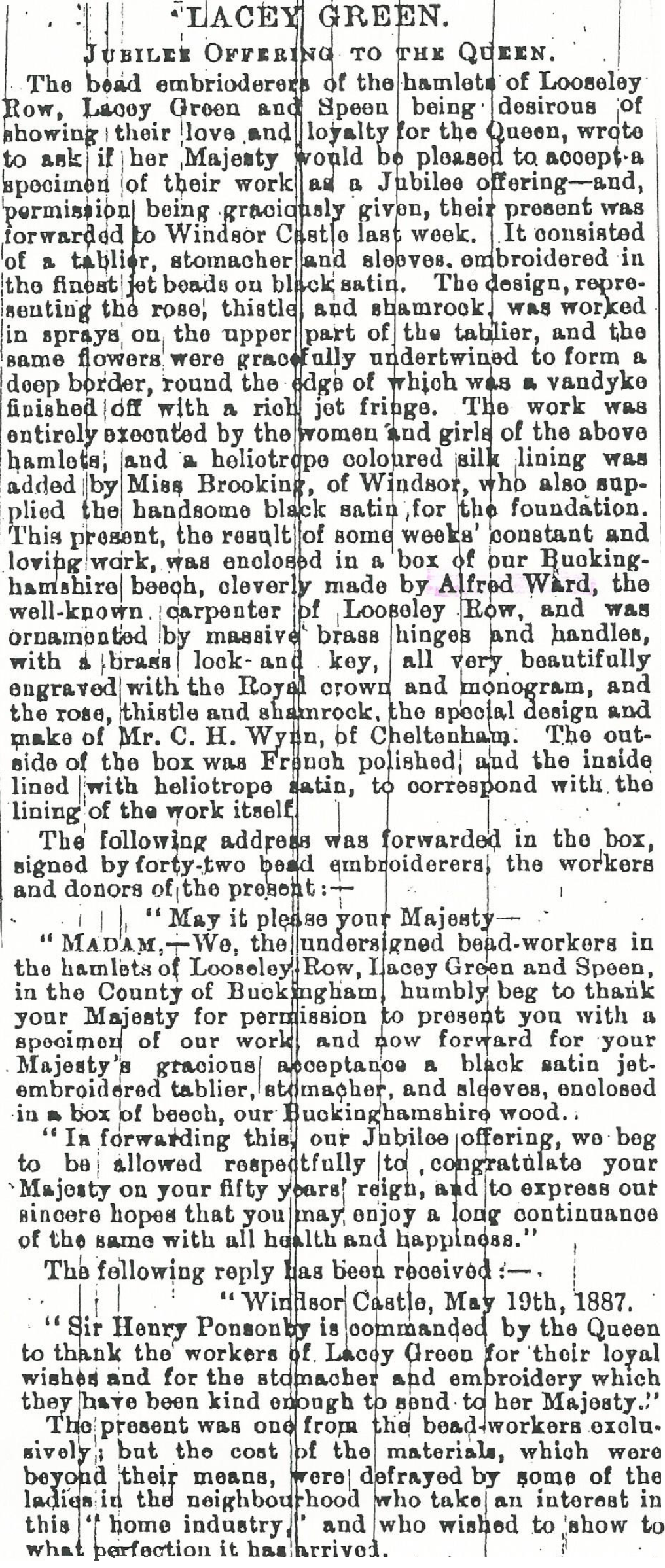
These women and girls were specifically named as ‘Beadworkers/Beaders or Lace-Beaders’ in the I891 census. Many others were recorded as ‘Lacemakers’ and could well have been involved in the making of the gift for Queen Victoria on her Golden Jubilee.
Lacemakers earned about half-penny an hour or 6d per day. The price of a loaf of bread then would have been over 1d! A minimal amount for so much work.
Beadworkers were paid more: a very small steel needle was used for beadwork and called a straw needle. Good eyesight would have been essential for this painstaking work.
| Clara Barefoot | 11 | John Barefoot | Carpenter |
| Lily Biggs | Father14 | Leonard Biggs | Sawyer |
| Annie Eustace | 21 | Abraham Eustace | Platelayer, Great Western Railway |
| Kate Eustace | 26 | Abraham Eustace | |
| Rose Eustace | 17 | Abraham Eustace | |
| Jane Ginger | 32 | George Ginger | |
| Laura Ginger | 26 | George Ginger | Carman |
| Lucy Ginger | 18 | George Ginger | |
| Emily Harvey | 15 | James Harvey | Railway Navy G.W.R. Lived at Coombes - the 'lost Hamlet of Loosley Row'. |
| Lizzie Hawes | 30 | William Hawes | Coachman |
| Lily Loosley | 12 | Owen Loosley | Chairmaker |
| Jane Randall | 26 | Thomas Randall | Blacksmith |
| Helena Thompson | 13 | d/o Widow Ellen Thompson |
Lacemaker |
| Julia Walker | 30 | Widow of Arthur Walker |
Farm worker |
| Annie Williams | 24 | James Williams | Foreman Platelayer G.W.R. |
| Ellen Williams | 19 | James Williams | |
| Thirza Williams | 22 | James Williams |
After her father's death Mary Ann Ward took over the Post Office and shop with the help of an assistant, Emily.
The 1911 census records:
| Mary Ward | Head | 27 | Single | Sub-Postmistress |
| Emily Jessie Clear | Assistant | 56 | Single | Assistant Postmistress |
The census, the last currently available to view, had an extra question for the householder to complete:
'Write below the number of rooms in the dwelling (House, Tenement or Apartment). Count the kitchen as a room, but do not count scullery, landing, lobby, closet, bathroom or warehouse'.Mary Ward wrote: 'six rooms'.
This photograph was taken c.1913/1914 and, possibly, on Mary Ann's wedding day, before she left for St John's Church, Lacey Green on 30 July 1913. The description in the newspaper report of her attire on that day resembles the dress and hat she is wearing in the photo.
The other female standing in the front garden of the Post Office was Emily Clear. The Postman standing outside the white picket fence was Leonard Frederick Rixon, who resided with his wife Edith Ellen (nee White) and their two young sons, Harold and Cecil in Loosley Row. It is said that Postman Rixon went daily to Bledlow Ridge to collect the mail and take same back to Loosley Row Post Office for sorting and delivery.
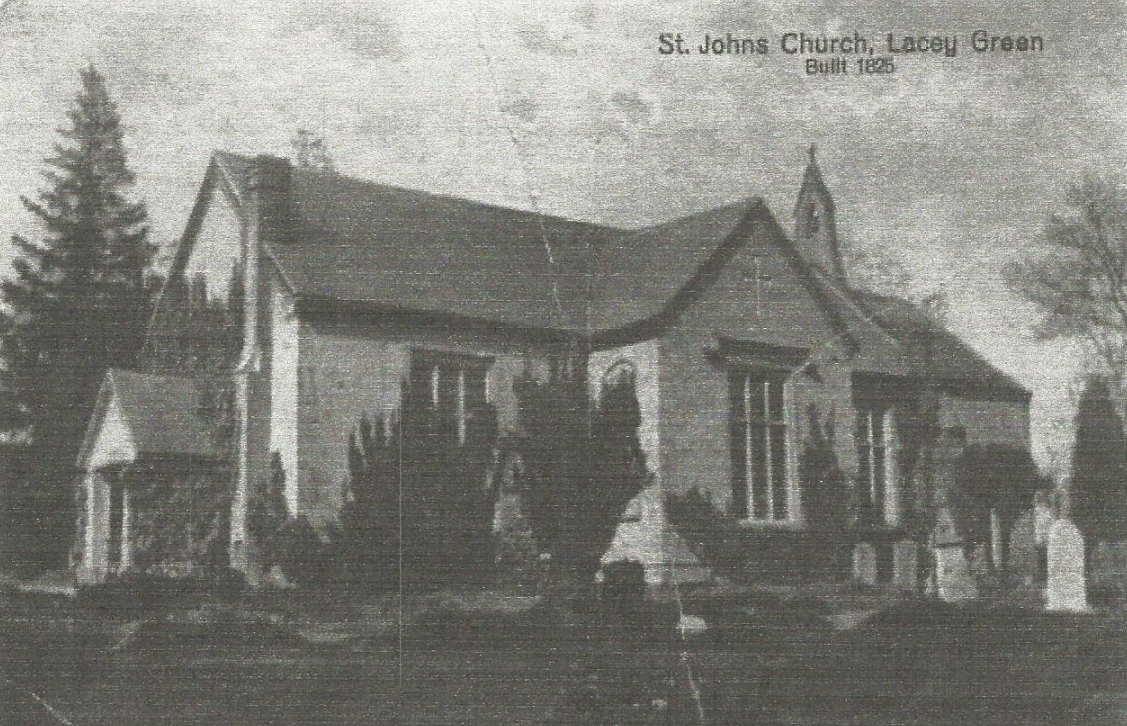
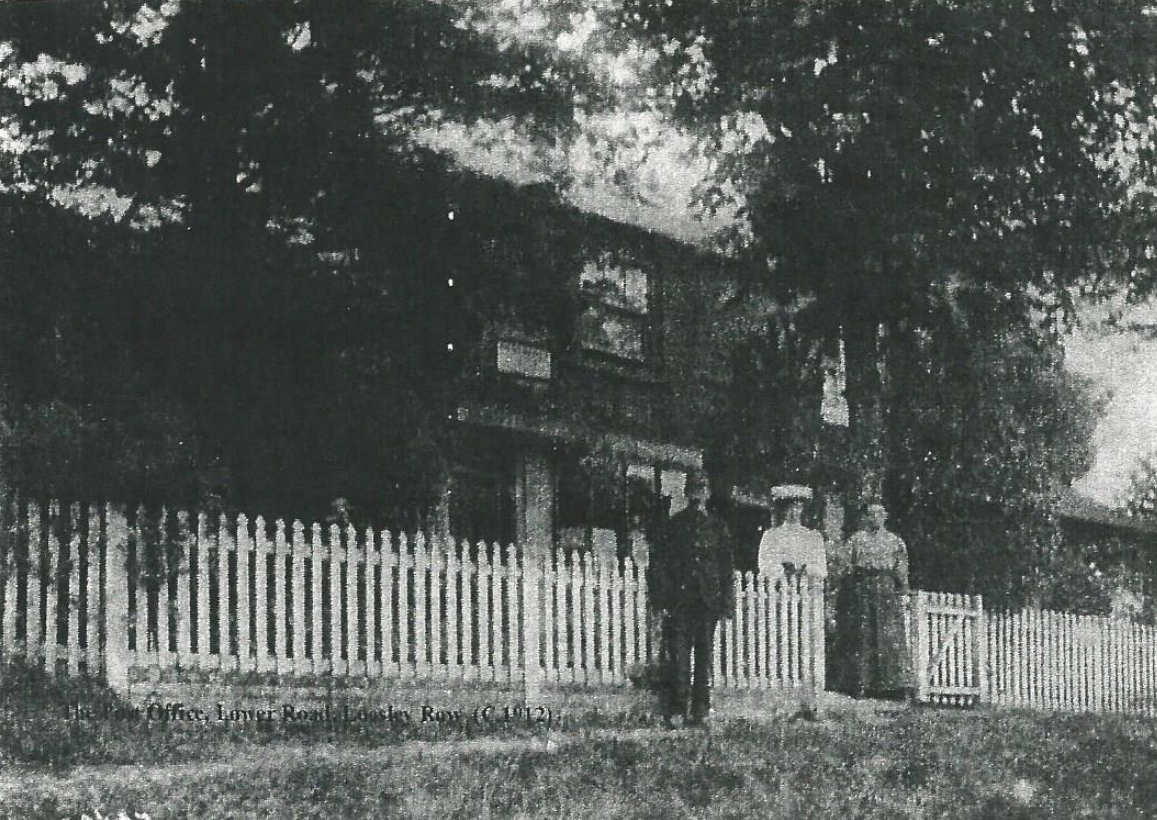
In 1913, Mary Ann Ward was married to Henry Allen at St. John’s Church, Lacey Green.

Newspaper report with with wedding gift list.
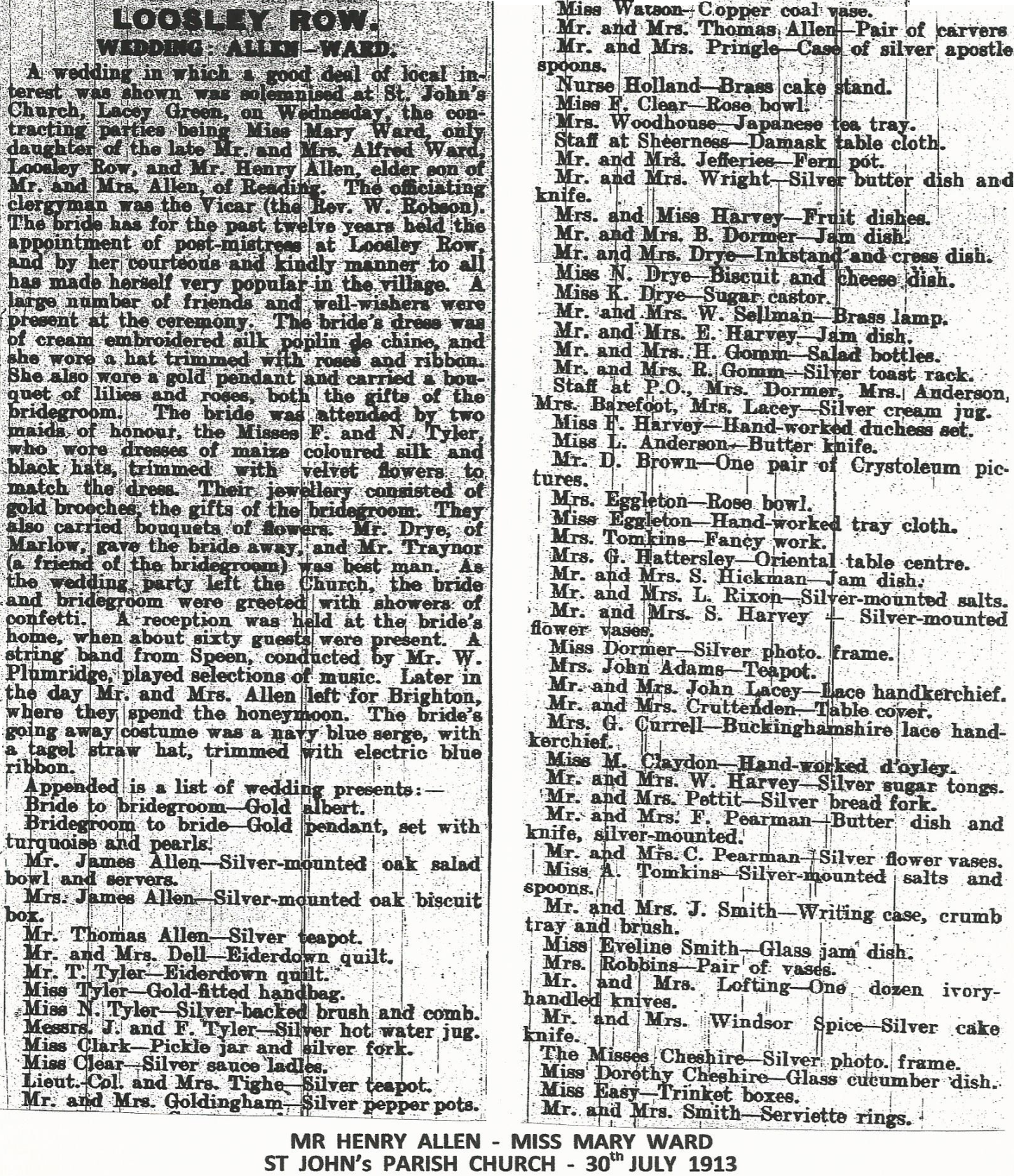
Henry Allen, husband of Mary Ann (nee Ward) of The Post Office, Lower Road, Loosley Row was a stationer prior to his marriage. After he took over as the Postmaster, he published a number of local postcards for sale in the shop and his name and address was printed vertically on the left hand side of the postcards.
The example below was sent by 'Mabel' staying or possibly employed at Collins Farm. She wrote the address at the top of her message to 'Nellie Ford' - a sister or friend living in Dalston, London.
The postmark on the King George V one penny stamp indicates it was posted, no doubt from the postbox still in use in Lower Road, on October 2, 1920 'Loosley Row; Princes Risborough, Bucks'
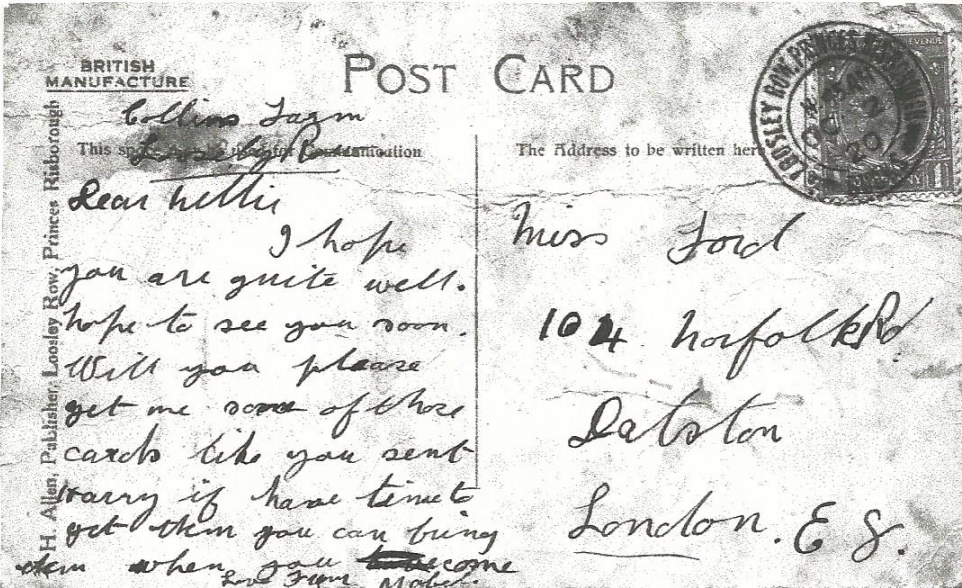
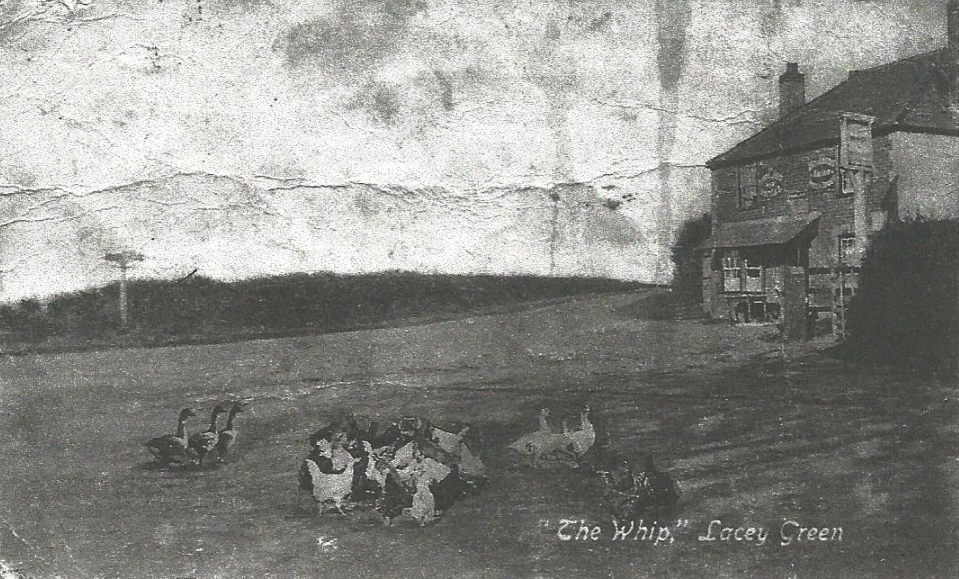
In a 1915 Kelly’s Trade Directory, Henry Allen is shown as Stationer and Post Office, Loosley Row.
A copy of a postcard dating from the early l900’s and depicting the Post Office at Loosley Row, Lacey Green Windmill and ‘The Sprat’ public house, was possibly sold from the Post Office.
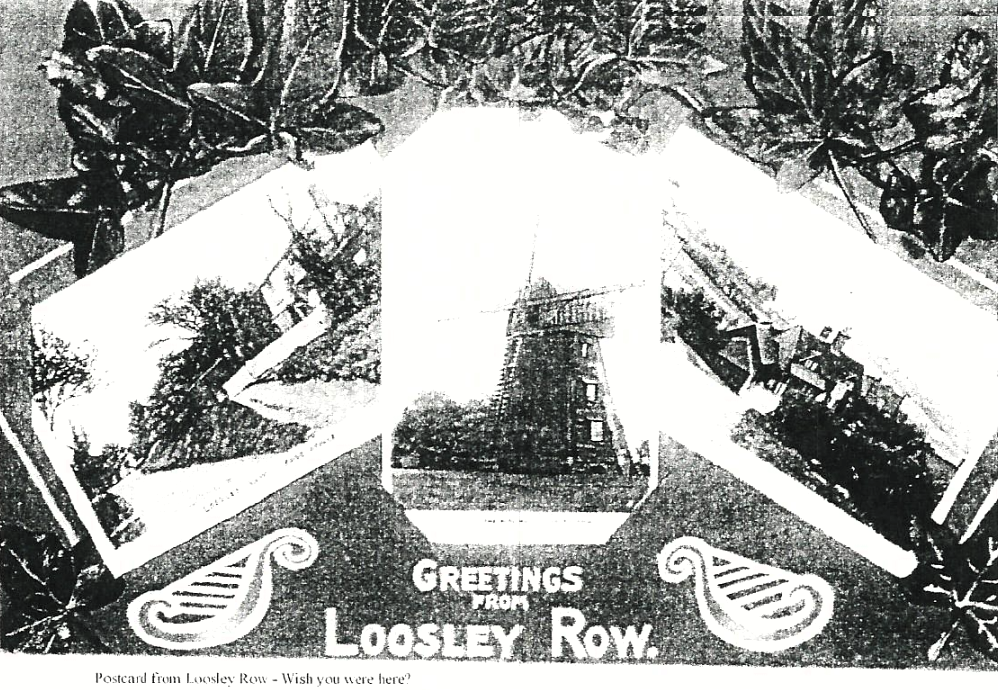
Born 29 June 1814 - a Master Carpenter and Joiner by trade, he was also celebrated as an accomplished cellist, playing in Speen Chapel Orchestra. Cornelius also composed and arranged hymns and other sacred music.
In 1897 - the year of Queen Victoria's Diamond Jubilee- when aged 83, he was honoured in a celebratory concert in High Wycombe, which included a performance of Ward's oratorio 'The Prodigal Son'.
In the 1901 census for Speen, Comelius actually gave his place of birth as Loosley Row. Whether this was correct or an error on the part of the census enumerator is unknown.
Cornelius Ward died on 2 November 1903 and lies in Speen Chapel burial ground.
Born about 1811 Jacob lived in Holly Cottage, Speen. Again a Carpenter, but he was obviously an early example of a 'multi-tasker'! Jacob was also an Undertaker, Builder, Coal Merchant .............and Village Constable.
Thomas and Charles were Cousins and both Carpenters. During the tragic event in July 1891 at Lacey Green Fete, held in the grounds of Grymsdyke, a sudden storm and flash of lightening struck people sheltering under a cherry tree. Three men were killed - one from Loosley Row, one from Lacey Green and the third from Speen. Thomas (age 25) and Charles (21) were injured, but survived.
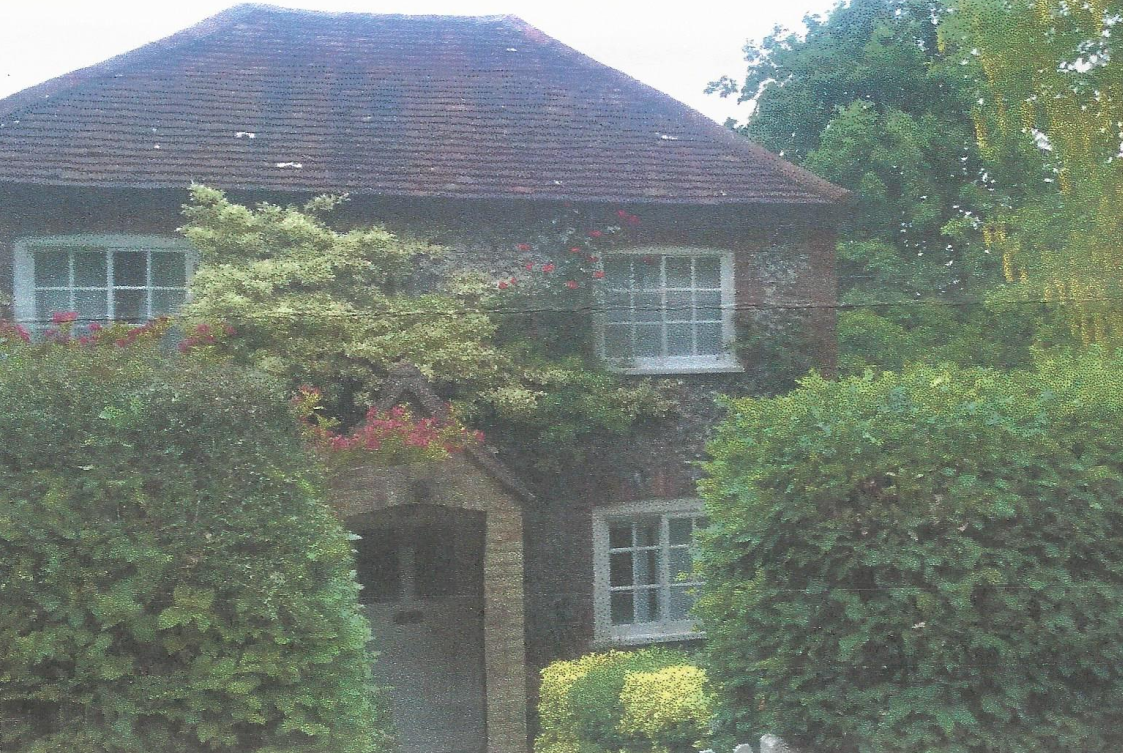
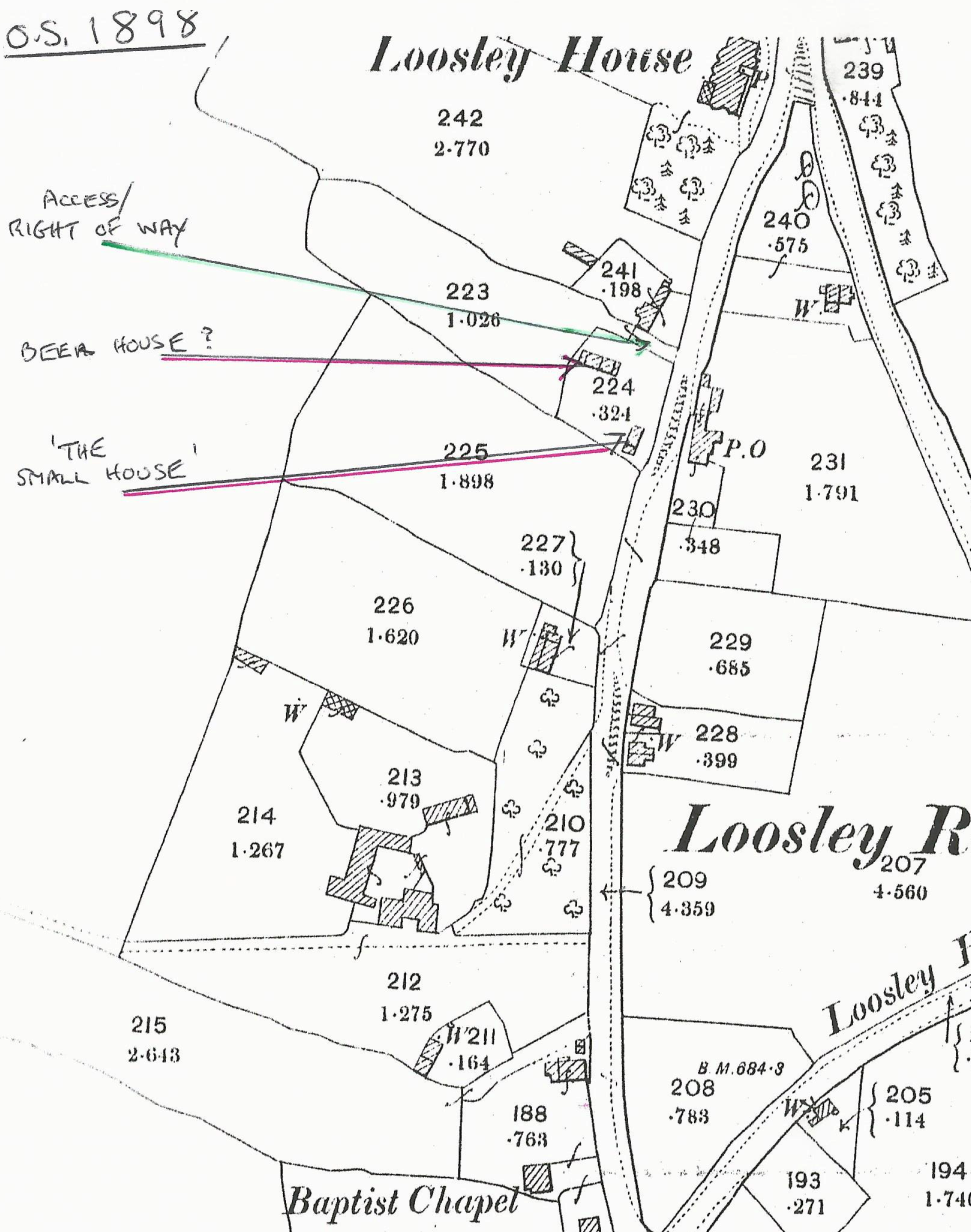
The 1823 Enclosure Map and accompanying Register for Plot No. 578a held in the County Record Office, Aylesbury describes the property, now known as The Small House as 'Cottage, garden and part of Crooked Close', which was then owned, but not necessarily occupied, by mother and son Sarah and Joseph Tyler of Collins Farm.
By at least 1861, possibly earlier, a Martha Ginger and family resided at The Small House:
Census 1861
| Martha Ginger | Head | Widow | 63 | School Mistress | b: Kingston, Oxon |
| George Maberley | son | Unmar. | 35 | Sawyer | Saunderton |
| Emma Ginger | dau. | Unmar. | 29 | Lacemaker | Loosley Row |
| Rebecca Ginger | dau. | Unmar. | 21 | Lacemaker | Loosley Row |
| Eliza Maberley | G/dau. | Unmar. | 23 | Lacemaker | Loosley Row |
| Isabel Ginger | G/dau. | 12 | Scholar | b: Marylebone |
lt is said that Martha Ginger had, in fact, established an unofficial school at The Small House to teach Lacemaking, which was not unusual in this area.
In 1871, George Maberley was still living there with his mother. The 1881 census records George, unmarried, living alone, aged 55 and employed as a Market Gardener born at Saunderton.
He was still at The Small House in 1891 when the census was taken and gave his occupation as a Small Gardener (self-employed). His widowed sister Maria Howard aged 72, a Lacemaker and her son William, unmarried, 32 years of age working as an Agricultural Labourer, were living with him.
The 1901 census records George, his sister Maria and son William still there.
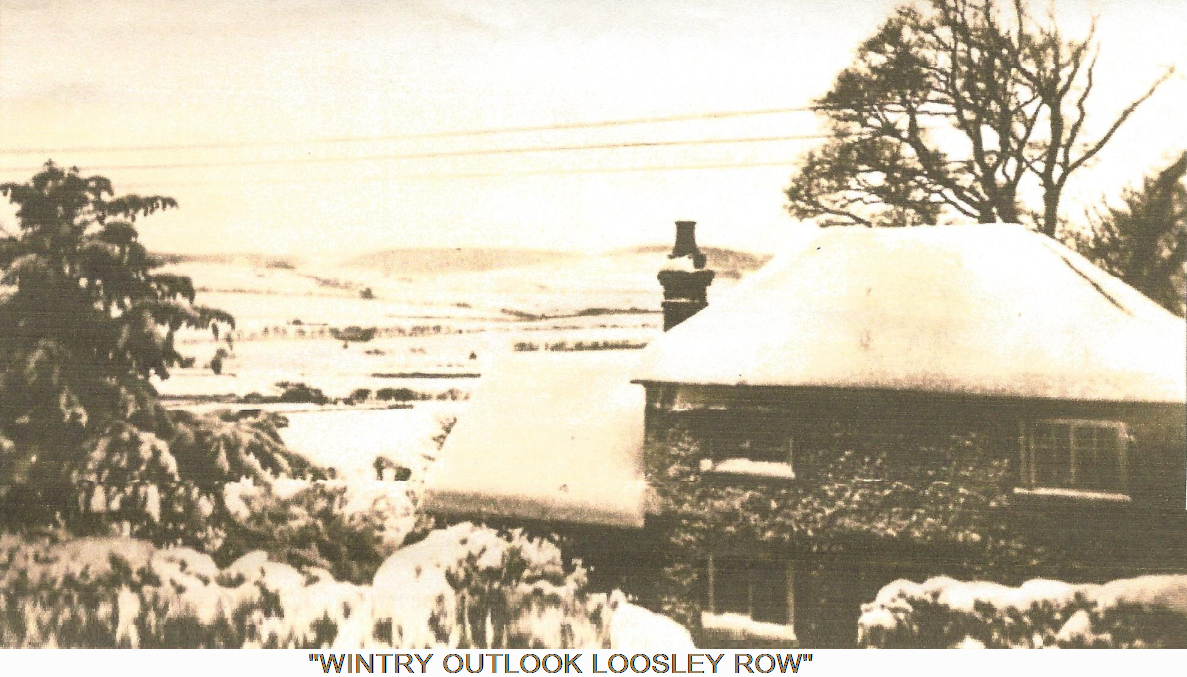
The Small House (photograph said to date from the early 1900's)
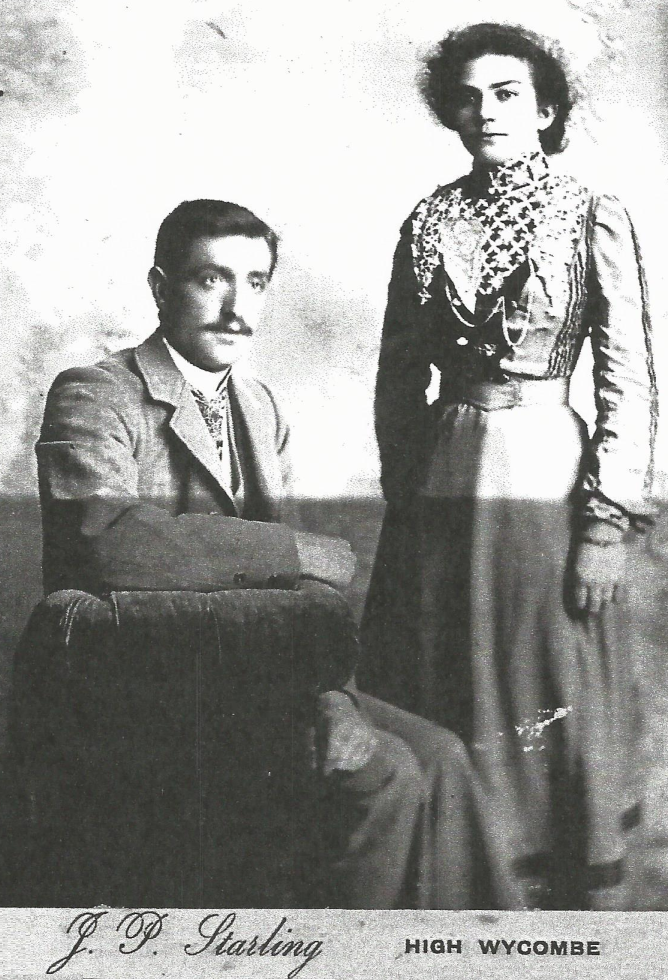
Sidney & Louisa Hickman (nee Rutiand) at time of their marriage
1911 Census:
| Sidney Hickman | Head of family | 34 | Bricklayer | |
| Louisa Hickman | wife | 30 | ||
| Reginald S. Hickman | son | 4 |
Sidney Hickman and Louisa Rutland were married on 4th October 1902 at St John's Church, Lacey Green. Their son Reginald Sidney Hickman was born in The Small House and Baptised at St John's Church, Lacey Green on 6th January 1907.
Beer/Ale House
Further intriguing information provided by Reginald's daughter, Betty Biggs (nee Hickman) indicates that there was access/or a right of way alongside the property, which led to a beer house situated about halfway down the plot of land/garden belonging to The Small House. A map dated 1878 clearly indicates the access way from Lower Road and the O.S. map of 1898, in fact, shows a property built sideways to the road in the area described. However, this building does not appear on the O.S. map of 1921.
There were a number of beer or ale houses in Loosley Row: no licence was required and beer brewed at home could legally be sold from same to friends, neighbours or passers-by.
Over the years nearby residents whilst gardening have found pieces of brick, tile, old nails and broken clay pipes in the location of the beer house. A local resident recalled seeing 'ruins' in the area.
Coincidentally, Louisa's father Harry Rutland was Malster (a brewer of beer). It seems likely that he had a connection with that particular beer house. The Rutland family lived not far away in Woodway in one of the five cottages known as The Bunch, Loosley Row.
A later occupant of The Small House was Jewish Physician Hans Ucko, born 19 January 1901. He came to England from Germany with wife Lotte just before the out break of World War 2 and their first address was 54 Welbeck Street, W1. He studied to be a Doctor at Berlin & Munich Universities and became a Professor of Endocrinology. Son, Peter John Ucko was born in London on 27 July 1938. Dr Ucko also took a great interest in music, conducting orchestras and arranging operas.
The family settled in Hampstead, where Dr Ucko established a private medical practice. The Voting Register for 1965 lists the family at Compayne Gardens, N.W.6. He bought The Small House as a weekend retreat, possibly soon after the 2nd World War.
The Small House did not have a telephone at that time, but one was located in the Post Office (now Green Pastures) directly opposite The Small House. It was arranged between the Postmaster, Mr Henry Allen and Doctor Ucko that when one of the latter's private patients telephoned the Post Of?ce wishing to speak to him, Mr Ward would open one of his upstairs windows and hang or wave a large red handkerchief out of same to attract Dr Ucko's attention that he had a telephone call waiting! Whether this unusual arrangement was successful is not known.
When Mr Allen retired and Loosley Row Post Office was transferred to Harvey's Stores, Lower Road, Dr Ucko bought the Old Post Office premises, where his son Professor Peter Ucko later resided.
Peter Ucko was an influential Archaeologist at University College, London and was also a Fellow of both the Royal Anthropological Institute and the Society of Antiquaries. He attained his BA and PhD in the Anthropology Department U.C.L., where he worked from 1962 to 1972, also publishing a number of significant books on Archaeology.
From 1972 to 1981 he was Principal of the Australian Institute of Aboriginal Studies in Canberra, Australia.
He lived at Green Pastures - the former Post Office, Lower Road, Loosley Row and will be remembered by many local residents.
Peter Ucko died in London on 14 June 2007 and was interred in Highgate Cemetery.
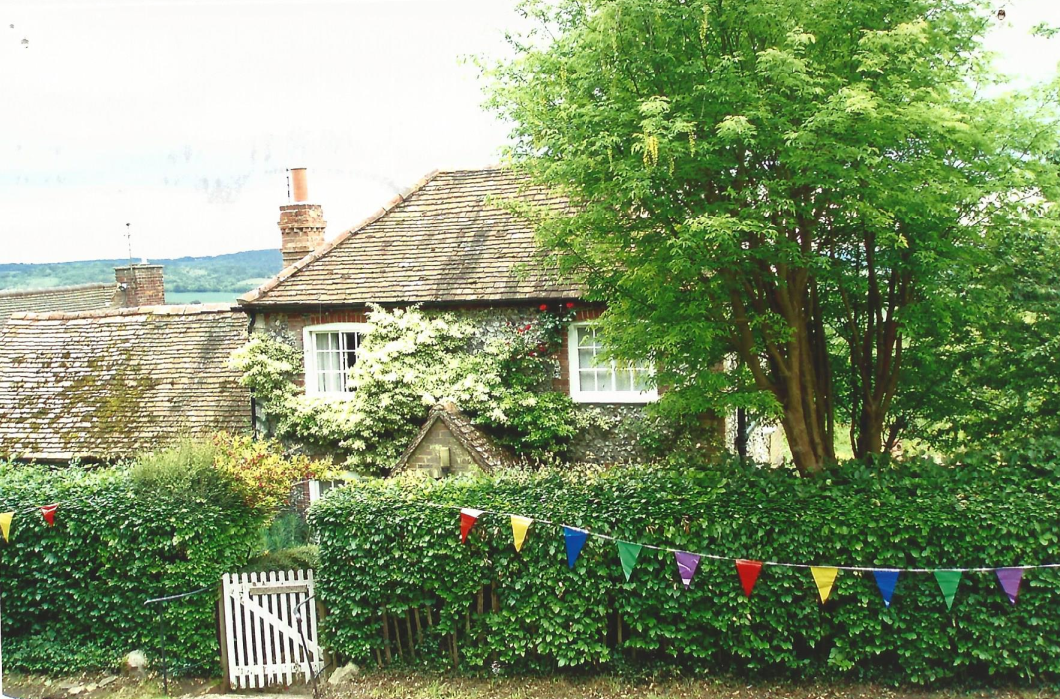
The Small House’ 2016
Decorated for Street Party
Queen Elizabeths’s 90th Birthday